Michael Jensen's Blog
August 22, 2025
Angkor Wat, Possibly the Most Amazing Place I've Ever Been

When I was seventeen and living in suburban Denver, Colorado, I saw Indiana Jones and the Raiders of the Lost Ark.
Over the following thirty years, I must have seen the movie a dozen more times. And each time, I had the same thought:
I want to have an adventure in the jungle! I want to explore ancient ruins like Indiana Jones!
Alas, living in the U.S., that seemed highly unlikely, and my Indiana dreams slowly faded.
Then two years ago, Brent and I decided to visit Cambodia.
And those teenage dreams finally came true as I explored the incredible ruins of Angkor Wat.
 The ruins at Koh Ker. Angkor Wat at Dawn
The ruins at Koh Ker. Angkor Wat at DawnBuilt in the 12th century by King Suryavarman, Cambodia’s most famous temple is aligned so that on the spring and fall equinoxes, the sun rises directly behind the highest tower.

The most coveted moment at Angkor Wat is watching the sunrise behind the five towers of the main temple, each representing a peak of Mount Meru, the mythical home of the Hindu gods.

The morning I went, there were only a few hundred people in the entire complex, making it possible to almost feel what it was like when King Suryavarman watched the same sunrise.
The experience was unforgettable.

Suryavarman and his priests studied the heavens, watching the stars trace their endless trek across the night sky. Like humans all across the world, they tried to divine mystical meaning in what they saw.

What meaning did they find? No one knows for sure, but for me, the meaning was found simply in being in such an extraordinary place.
The Many Mysterious Faces of Bayon TempleSo many amazing sights fill Angkor Wat that it’s hard to choose my favorite.
But Bayon Temple is at the top of my list.
Bayon, built fifty years after Angkor Wat, is most famous for its more than 200 serene faces gazing out from its towers.

Scholars believe the image may be a religious figure named Avalokiteshvara, King Jayavarman VII, or a blend of both.

Bayon’s maze-like corridors are also filled with intricate bas-reliefs of battles, religious ceremonies, and daily life, combining Buddhist and Hindu elements.
I found them endlessly fascinating to study.
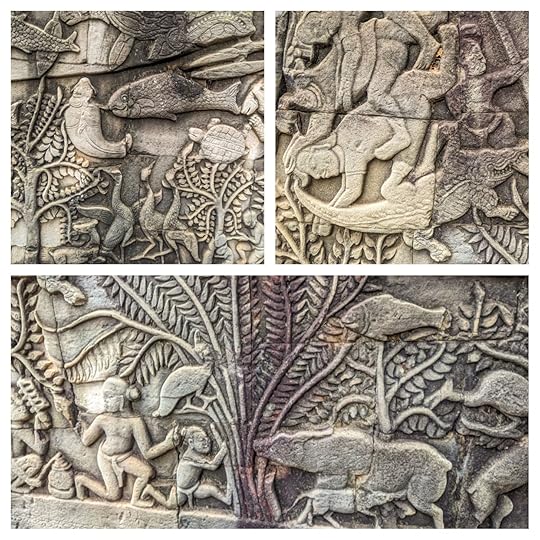
But more than two years later, it is those serene faces I see when I close my eyes and think of Bayon Temple.

Ta Prohm — Where Indiana Jones Comes to Life
Welcome to my other favorite temple — Ta Prohm.
Built in the 12th century by King Jayavarman VII, Ta Prohm served as a monastery and center of learning dedicated to the king’s mother.

Wandering through Ta Prohm was where my Indiana Jones fantasy most came to life.
I clambered over fallen stones, stared at towering strangler figs blotting out the sun, and stood in ruins that felt like half-jungle, half-sacred space.
As I looked around, I felt certain that if only I picked the right doorway, I’d discover a lost vault filled with the gold, silver, rubies, and sapphires that the kings of Angkor Wat coveted.
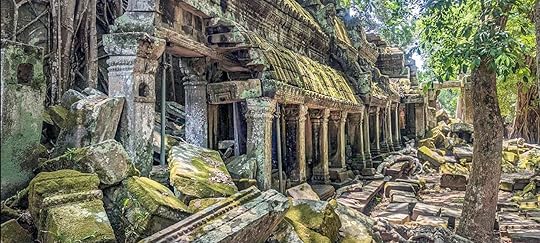
Why is Ta Prohm in such a state of elegant decay?
Because it was built without mortar, and after the Khmer Empire fell in the 15th century, the jungle swiftly encroached on the abandoned buildings.
Ever so patiently, the strangler figs worked their way into gaps, prying the buildings apart and knocking them to the ground.

Unlike many other temples, which have been painstakingly reconstructed, Ta Prohm has largely been left as it was found. (Which is why Lara Croft: Tomb Raider, starring Angelina Jolie, was partly filmed here.)

And that’s where the magic lies — in seeing these ruins as they were before being “rediscovered” in 1860 for the West by Henri Mouhot, France’s own Indiana Jones.
Or Côte d'Azure Rousseau, if you’d like.

Terrace of the Leper King
This intricately decorated terrace gets its name from a moss-covered statue thought to resemble a leper, though it likely represents Yama, the Hindu god of death.
Or perhaps it’s a Khmer king. There’s no way to know.

Behind the outer wall, archaeologists discovered a hidden inner wall decorated with detailed carvings of nagas, garudas, yaksas, apsaras, and devatas.
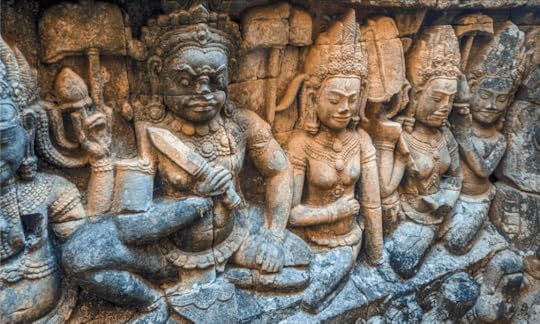
The imagery depicts the underworld below and spiritual beings rising toward the light.

A fine-grained yellow/grey sandstone was used for the carvings, which made it possible to carve so much detail into the stone.

But where did that sandstone come from?
From the Kulen Mountains, which lie up to forty kilometers from Angkor Wat.
Quarrying and transporting the stone to the temple sites required entire communities devoted to doing nothing but quarrying and moving the stone.
And elephants. Lots and lots of elephants!
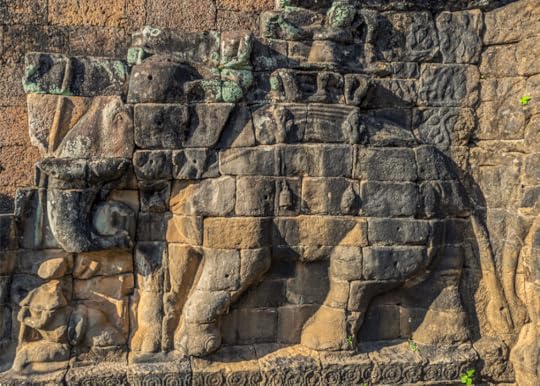
Those elephants dragged the stone down from the mountains to canals dug by hand and then filled with water.
Once the blocks of stone were floated to Angkor Wat, elephants — and possibly people — were used to transport the sandstone to the construction sites.
There the scenes of Angkor Wat came to life in stone.
Koh Ker — Before There Was Angkor Wat

Located 120 kilometers from Angkor Wat, Koh Ker predates it by two centuries and briefly served as the Khmer Empire’s capital.

Today, Koh Ker feels remote and rarely visited, with most of its 100+ structures still hidden by jungle and not open to tourists.
We only know of their existence thanks to aerial surveys and ground-penetrating radar, which reveals temples hidden to the naked eye.
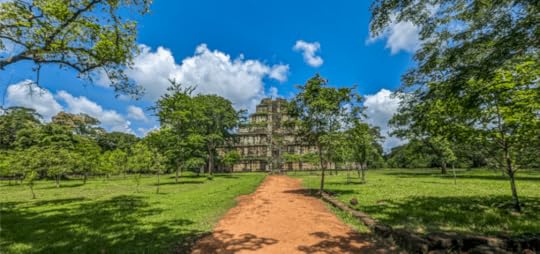
Highlights include Prasat Pram, where strangler figs engulf the ruins, and Prasat Prang, a 36-meter (118-foot) seven-tiered pyramid that towers above the forest.

And from the top of Prasat Prang, we saw nothing but jungle stretching away in every direction.
The town of Siem Reap was a two-and-a-half-hour drive away over bumpy roads, and the city of Battambang was another two and a half hours from there.
For the first time, I truly grasped just how far from everything we were.

No, I hadn’t retrieved any golden idols or run from a giant stone rock.
But I had still come pretty damn close to feeling like Indiana Jones.
If you enjoyed this newsletter, I would appreciate your sharing it with someone you think might also like it.
Michael Jensen is a travel writer, amateur photographer, and novelist. Check out his other newsletter about his travels at BrentAndMichaelAreGoingPlaces.com.
July 8, 2025
El Divo Presents: Barnacles, Botox, and Boatyards
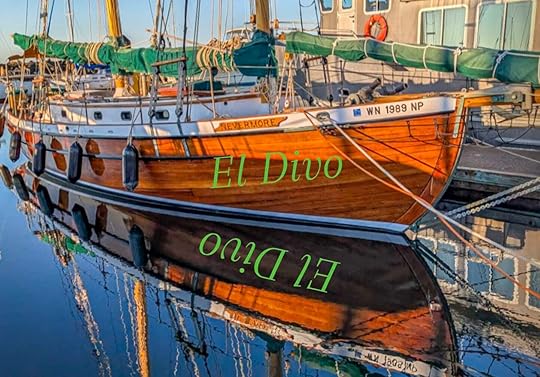
I know what you’re thinking: El Divo, last month was Pride! Where in the name of Dorothy’s red ruby slippers was Michael’s sarcastic gay camera?
Por que are you asking me? You should query the fellow who writes this newsletter, as I am definitely not upper management.
Fear not, though, El Divo is back, and while I don’t have any Pride photos of me sitting imperiously upon a float — the only way I sit, of course — this month, I do have something else for you that floats.
Boats. Lots and lots of boats.
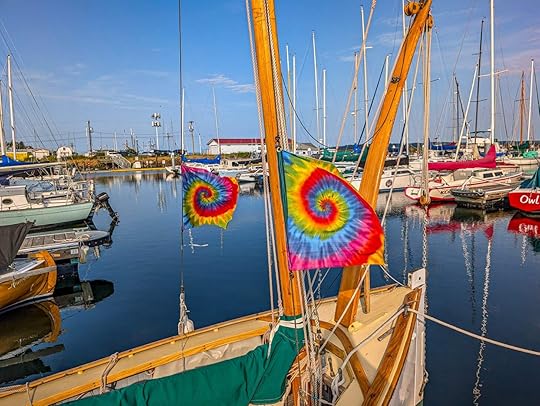 Alas, as close as we’re getting to Pride this newsletter.
Alas, as close as we’re getting to Pride this newsletter. Yes, Michael’s fancy has been captured by the Port Townsend Boatyard, where all sorts of floaty contraptions school together like delicious anchovies waiting to be netted by a hunky Italian fisherman named Niccolò who turns his gaze upon you and…
Mi scusi. It’s been a while since El Divo has had male companionship.
I am Michael’s gay camera, remember?
Anyway, let us not dwell on that and instead focus on the boatyard, where one will find schooners, trawlers, yachts, ferries, sailboats, and all manner of maritime contraptions.
There’s even a boat with connections to pirates, which I shall get to in a bit.
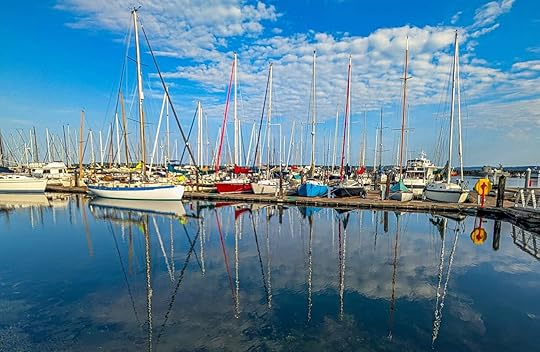
Why the Port Townsend Boatyard, you might ask?
Well, mi dolce companions, Port Townsend, situated on the Olympic Peninsula and overlooking Puget Sound, is where Brent and Michael reside during their yearly visits back to the U.S. and they were just there, so naturally Michael had to take pictures.
True, Port Townsend is no Portofino, Positano, or Polignano a Mare. Then again, few places are because, well, Italy.
But Port Townsend is a charming port town with lovely Victorian buildings and a rich maritime history dating back to the 19th century.
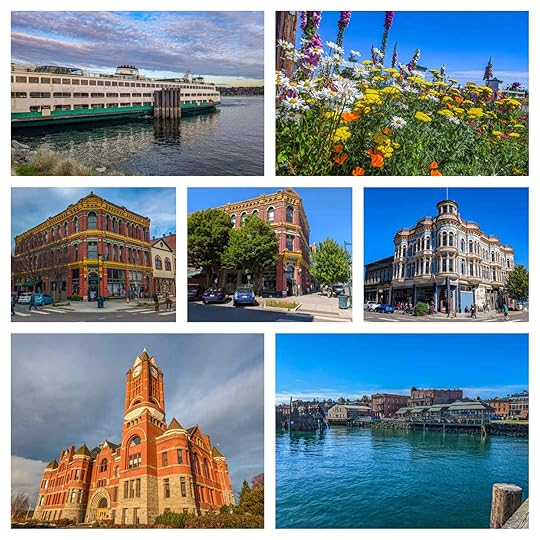
Port Townsend is also known as a hub for wooden boat enthusiasts and is home to the second-largest wooden boat festival in the world.
And at the Northwest Maritime Center, people can even learn the time-honored craft of building a boat. There, one can imagine a shirtless, hairy-chested Niccolò vigorously sanding away while—
Perdono, El Divo allowed himself to become distracted once more.
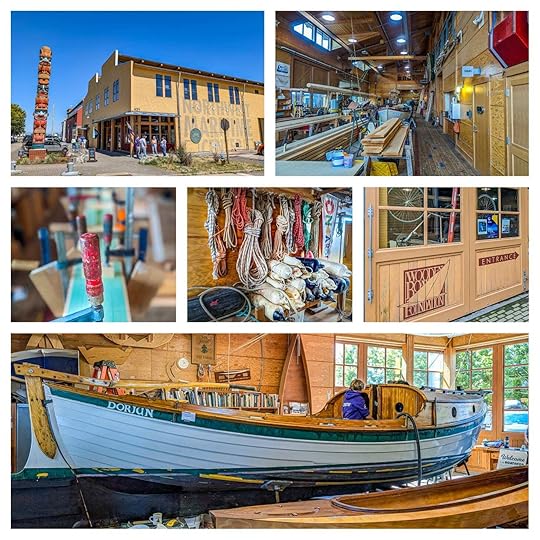
In this era of cheap disposable goods, El Divo is genuinely impressed by Port Townsend’s devotion to passing on its nautical heritage. Of course, Michael went crazy taking photos at the Maritime Center — and even more so at the boatyard.
However, the boats at the boatyard do not float in the water.
No, most of these boats aren’t even in the water.
Instead, they are in dry dock, having been hoisted land-ho using a boat sling.
 This sling is not messing around!
This sling is not messing around!The technical term for the sling is a Marine Travel Lift, and the one at Port Townsend can raise a boat weighing up to 330 tons and 150 feet in length.
Mama Mia! as they say in Italy. (I jest, of course. That only happens in bad American movies.)
Once a boat is lifted out of the water, it’s placed on keel blocks: pieces of wood or concrete on which the keel of the boat rests so it doesn’t tip over.
Sort of like a drag queen perched on high heels.
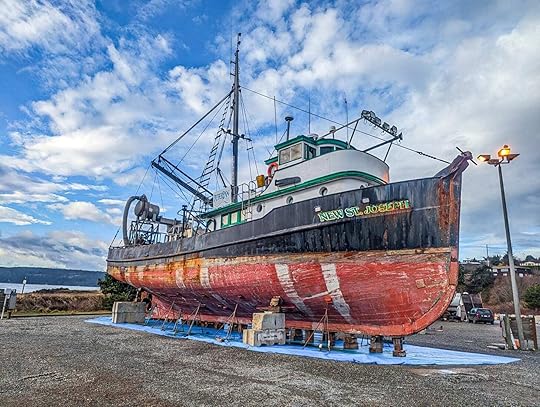 Keel blocks are such an inelegant name. Let’s call them the stilettos of dry dock.
Keel blocks are such an inelegant name. Let’s call them the stilettos of dry dock.Why are these boats hauled out of the water like tuna being scooped up to make a fresh ceviche with an avocado vinaigrette paired with a crisp Riesling that Niccolò lovingly—
Dear, dear, dear. This is becoming a problem.
The boats aren’t in the water, dear companions, because boat ownership requires much maintenance to stay looking ship-shape. Work that cannot be done while sailing the seven seas.
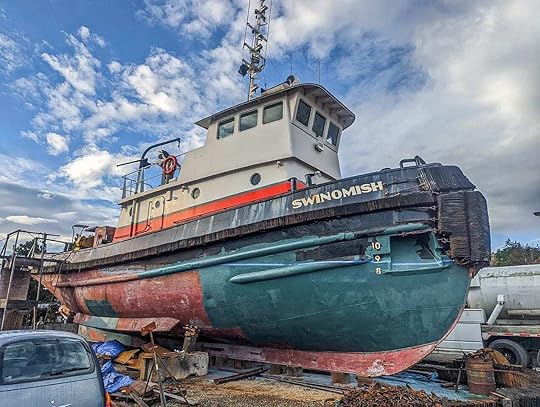
The hull must undergo high-pressure washing to strip away barnacles, algae, rust, and any other unpleasant corrosion. Basically, it’s a chemical peel for boats.
Then the hull is repainted and patched, and some other nautical necessities happen, like deck-swabbing, varnishing, and tightening the petards until someone screams “ahoy!”
 El Divo feels certain the “petard” is up there somewhere.
El Divo feels certain the “petard” is up there somewhere. Okay, fine. El Divo confesses they don’t know what a “petard” is and made up that last bit.
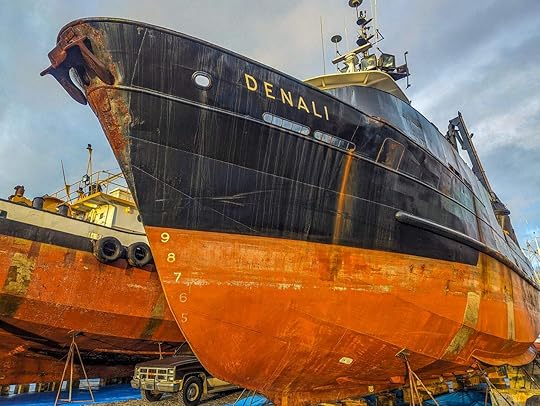
So the boat is basically getting a makeover leaving it “refreshed” and ready to sail the high seas once more.
Or, to put it in terms much of this readership will relate to: the boatyard is what happens when a luxury day spa rendezvous with a gym and a discreet, highly skilled plastic surgeon. There is exfoliation. There is heavy lifting. And, eventually, there is transformation — if not rebirth, then at least a well-buffed illusion of youth.
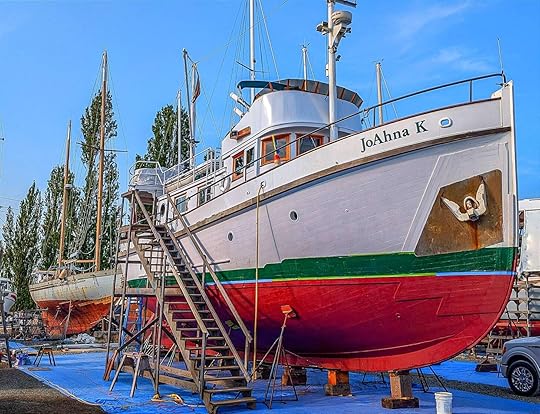
Some boats need a bit more rebirth than others.
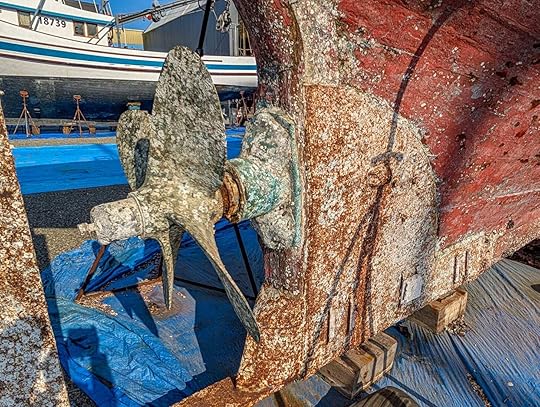
Naturally, Michael had to take pictures of every single boat.
I should probably cut the poor fellow a little slack for going so picture-crazy. I must admit there is something special about seeing these boats removed from their natural element.
The hulls with their graceful curves, the way their keels taper to such narrow points.
It is rather heroic.
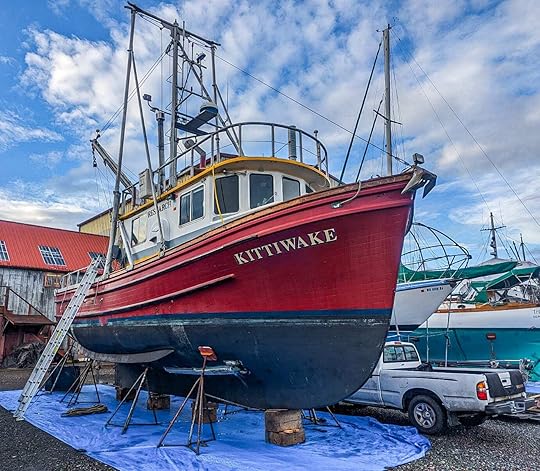
After all, these boats are brave enough to challenge the oceans, which are among the most powerful forces on Earth.
Aside from El Divo, of course.

And when a boat is illuminated by the golden hour and ends up looking like something out of a painting?
Well, that’s a little bit of magic, no?

There is also a vulnerability to these boats, which arrive battered and beaten down by the elements, and put on display, with all their flaws in plain view of the world.

Imagine Michael, stripped naked, balanced on keel blocks, waiting for a power washing.
Actually, let’s not do that.
Let us instead picture the aforementioned Niccolò once more, posed like Michelangelo’s David in all his glory, gleaming as—
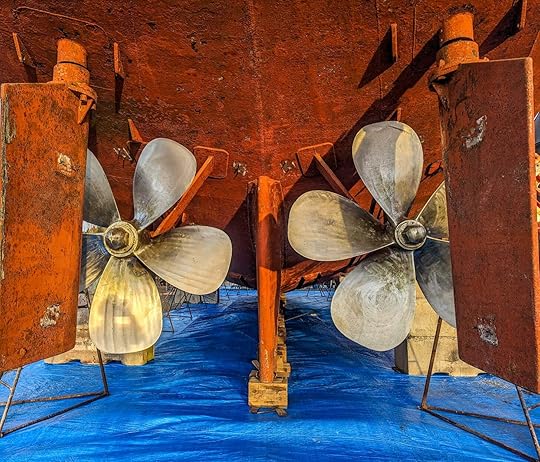
Heavens to bruschetta! El Divo must arrange a date pronto pesto!
El Divo admits he’s especially fond of Michael’s work with the boat’s reflection in the waters of Puget Sound.
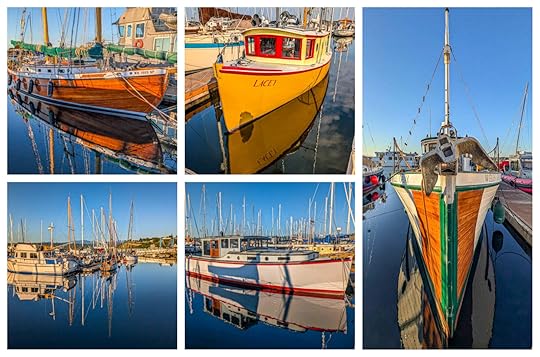
Gentle companions, we are almost at the end of this missive. I know, I know! I promised you a pirate story.
Here is Michael’s pirate story — of sorts.
He’d been wandering around the boatyard snapping away as he is wont to do when a man in a truck pulled up next to him.
At first, Michael thought he might be trespassing and was about to get a scolding. Instead, the man asked what Michael knew about the Lady Washington, the boat he was currently photographing.
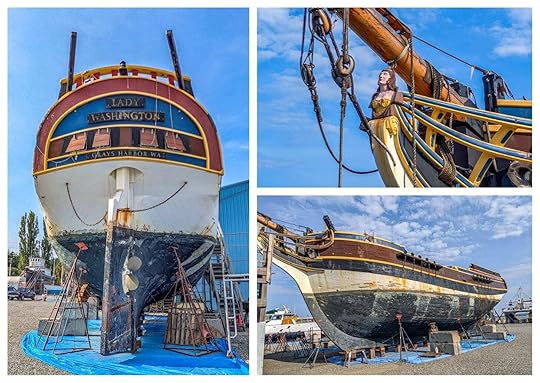
When Michael admitted he knew nothing, the fellow excitedly explained that the Lady Washington had had a minor guest part in the first Pirates of the Caribbean movie as well as the movie Star Trek: Generations.
Michael, himself a Trekkie, was suitably impressed.
Yes, the Lady Washington is looking a little ragged at the moment.
Thankfully, she’s come to the right place and I feel certain in the skilled hands of Niccolo, she will be looking bellissimo in no time at all.
 Niccolo!
Niccolo!That’s all for now, mi amores! Until next time, I remain your devoted El Divo!
If you enjoyed this newsletter, I would appreciate your sharing it with someone you think might also like it.
Michael Jensen is a travel writer, amateur photographer, and novelist. Check out his other newsletter about his travels at BrentAndMichaelAreGoingPlaces.com.
May 31, 2025
What the English Town of Bootle Taught Me About Love, er, "Luv"
 The street we stayed on in Bootle.
The street we stayed on in Bootle. Don’t feel bad if you’ve never heard of Bootle, England.
Most folks outside the UK haven’t. Honestly, I’d wager a fair number of people inside the UK haven’t either. It’s a small town on the edge of Liverpool, and it doesn’t have much to recommend it.
I only know Bootle because it was the only affordable Airbnb we could find during Brent’s Beatles pilgrimage to Liverpool.
 So close yet so far.
So close yet so far. When our Uber pulled up in front of our place, Brent and I exchanged a “What have we done?” look. The street was loud, the building old and gritty, and the entire area had the pre-gentrification feel of 1980s Brooklyn.
 Not our building but pretty typical of our neighborhood.
Not our building but pretty typical of our neighborhood. A little Googling revealed what my eyes had already guessed: Bootle, heavily bombed during WWII, was mostly passed over in the post-war redevelopment frenzy.
Funding went to better-off areas, leaving Bootle with a raw deal. The town now struggles with poverty and crime, and people here live, on average, twelve years less than residents of wealthier nearby neighborhoods.
A look at Reddit showed people who didn’t live in Bootle, didn’t have much nice to say about it.
 A pretty typical view of Bootle.
A pretty typical view of Bootle. If England had a “flyover country,” this would be in the heart of it.
And that’s a shame — not because it’s secretly brimming with culture or great food or stunning architecture. It isn’t.
But it has something else, something harder to find: a certain kind of quiet, human grace.
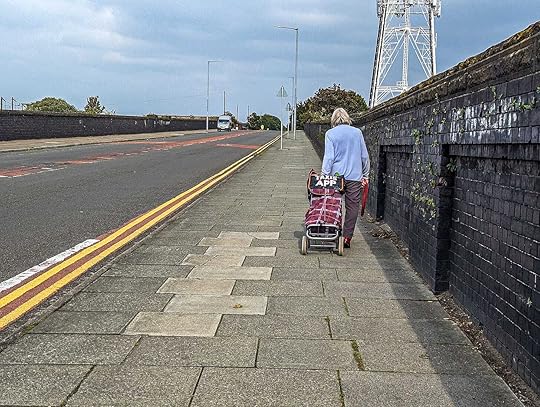
One of the first things I noticed was how people in Bootle talked to each other. Everywhere I went, I heard the word “love” — or, more accurately, “luv.”
Yes, Brits are known for using the word, though its usage is dropping. But Bootleians drop l-bombs the way the Roy family on Succession drops f-bombs. “Hello, luv,” “Have a good day, luv,” “Thanks for coming in, luv.” Even the burly security guard who stopped us from entering a closed shop did it kindly: “Sorry, luv. Closed for the day.”
Yes, in Bootle, even men use the word “luv” with other men.
It might’ve been jarring to my American ears, but honestly, it was… well, luvly.
The social and commercial heart of Bootle is a tired little mall called the Strand.
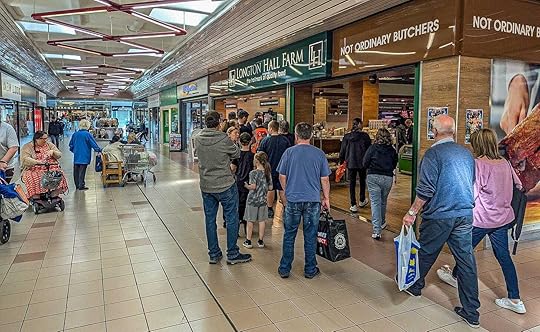 The Strand at its best.
The Strand at its best. Despite a recent facelift, much of it looks worn out — like the pensioners waiting at the nearby train station. The shops inside reflect Bootle’s economic reality: discount stores like Poundland and Iceland, a vape shop called Kaboom, Hairlucinations (yes, really), and the ever-present Ladbrokes betting office.
Then there were the empty storefronts, looming like ghosts of the businesses that had died but had yet to pass on to the next life.
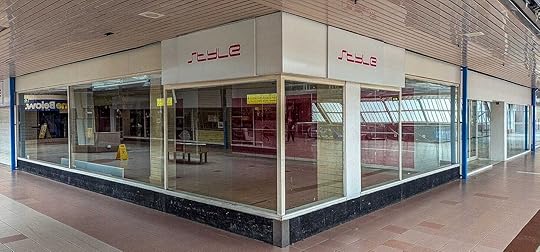 Just one of the empty storefronts in the Strand.
Just one of the empty storefronts in the Strand. And if the name “Bootle” does ring any bells, it might be because of the Strand. In 1993, it was the site of one of the most shocking crimes in UK history: the abduction and murder of two-year-old James Bulger by two ten-year-old boys. That story clings to the place like soot in the corners of a window.
So no, I can’t recommend you go out of your way to visit Bootle.
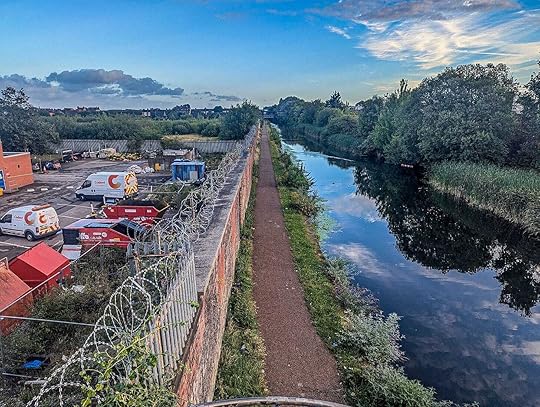 Bootle does what it can with what it has, including a series of canals. Yet those efforts are often overshadowed.
Bootle does what it can with what it has, including a series of canals. Yet those efforts are often overshadowed. But I am glad we did. Because it was there, in that unremarkable mall, that I witnessed one of the most touching acts of community I’ve seen in eight years of nomading.
It happened at The Coffeehouse, a small UK café chain. I went there most mornings to work, and over time, I began to notice the regulars: moms with prams taking a breather, elderly couples on autopilot with tea and jam-slathered muffins, disheveled women with curlers, groups of teens absorbed in their phones.
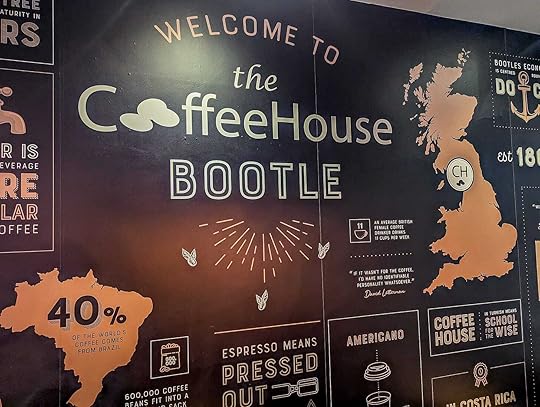
It wasn’t diverse by any stretch — Bootle is very white and very working-class — but it had the quiet rhythm of a place where people knew each other’s routines.
And then there was Iris.
I heard Iris before I saw her.
“I’M NOT LATE TODAY, AM I?” she bellowed, entering. “DON’T WORRY. I’M HERE NOW!”
Loud, staccato speech, thrown like a punch. At first, I thought she was mad at the barista, maybe, or another customer. But no one else seemed alarmed.
“IS MY TABLE FREE? I HOPE SO. ”
No one else paid her much mind, so I returned to work, figuring the commotion was over.
 Iris at her usual table.
Iris at her usual table. But the next day, same time, same volume: “HI JACKIE! LOOK WHAT I BROUGHT! ISN’T SHE PRETTY?”
Iris held up a doll, beaming. The barista smiled. “She’s beautiful, luv.”
That was my first proper look at Iris. Late fifties or early sixties, short auburn hair held back by a headband, big black glasses, jangly jewelry, and a trolley cart decorated with Pokémon keychains. Her outfit was neat but simple — slacks, blouse, sensible shoes — but the accessories added flair.
Her voice, though, was relentless. Atonal, loud, and impossible to ignore.
It didn’t take long to realize she was probably autistic. And that her shouting wasn’t aggression — it was just how she spoke.
Usually, someone would join her: a barista, sometimes another customer. The pattern was always the same. They spoke normally; Iris replied at full volume. “YES, I DID.” “THAT’S GOOD TO HEAR.” “THANK YOU VERY MUCH.”
I like to think I’m a decent person, so I didn’t object to Iris’s presence, despite how her voice grated — and it really did. However, I needed to work, so I started wearing earbuds. They didn’t block her out entirely, but they helped.
Then one morning, a woman sat at the table next to me — the first person I saw visibly bothered by Iris. Loud sighs, annoyed glances, escalating frustration.
Finally, she snapped: “Please stop shouting! It’s awful!”
Iris froze. The café fell silent. A barista knelt beside her and whispered something. Then Iris called out, “I’M SORRY!”
Another customer leaned toward the upset woman and said, gently, “That’s Iris, luv. She comes every day. She can’t help the way she talks.”
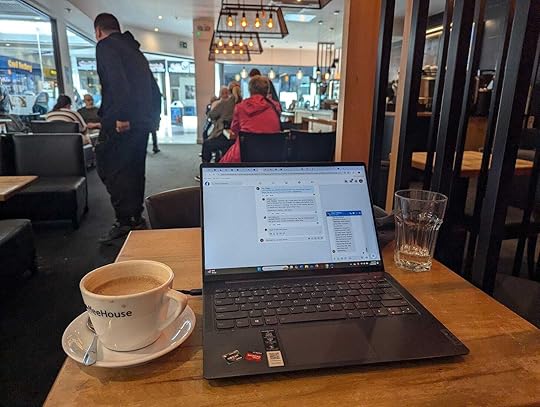
The woman frowned, apparently unsure what to do with the new information. Iris’s volume of speech was probably hard for her to control. That didn’t make it any easier to listen to. Finally, the woman said, “I didn’t realize. I’m sorry. It’s just… so unpleasant.”
“I know, luv,” the other woman replied. “But we all have to get along, don’t we?”
When the frazzled woman left a little later, she stopped by Iris’s table and said something I couldn’t hear. I’m guessing it was an apology.
The kindness in that coffee shop moved me more than I expected. No one lashed out. No one shamed anyone. There was grace for everyone — Iris, the annoyed woman, the coffee shop’s staff. It was quietly extraordinary.
Later, I mentioned it to the barista.
“That happens now and again, luv,” she said. “Most folks here know Iris, but not everyone.”
“She’s here often?”
“Every day. Lives on her own. She started coming in four years ago. Now we give her free coffee, and everyone chats with her. She loves folding the napkins for the tables and does it perfectly. She’s very sweet. She brings me gifts for my little girl. Never says a bad word about anyone. And you know, folks around here — we know what it’s like to be looked down on. So we make sure she’s treated well.”
That stuck with me.
“Is there anything else?” the barista asked.
“No,” I said, handing over a ten-pound note.
She gave me my change and said, “Have a good day, luv.”
I smiled.
Bootle doesn’t have much — not in the way travel guides measure things.

But I’ve rarely seen a place with more heart.
I’ve been thinking about the kindness I saw there a lot lately. The world doesn’t exactly reward patience or empathy these days. And yet, here was this little town showing us how it’s done.
Maybe the first step is small. Maybe it’s just saying “luv” a little more often.
I’ll start.
Thanks for reading. Have a great day, luv.
Note: I didn’t use Iris’s real name.
If you enjoyed this newsletter, I would appreciate it if you shared it with someone who might also like it.
Michael Jensen is a travel writer, amateur photographer, and novelist. Check out his other newsletter about his travels at BrentAndMichaelAreGoingPlaces.com.
May 2, 2025
El Divo Returns! Cherry Blossoms, History, and Very Droll Commentary!

Greetings and salutations. It is I, El Divo.
I have returned.
Of course, I have.
Did you see how many likes the first newsletter I narrated got? Almost eighty. That’s way more than that dragon in Bangkok got. I even bested Jane Austen, which is no mean feat given how many movie adaptations of her books there have been.
As they say in the business, a star is born.
Speaking of Miss Austen, I’m partial to the version of Pride and Prejudice with Keira Knightley because, let’s be honest, the glamorous and sublime Ms. Knightley and I have much in common.
But enough about me.
It’s time to talk about this month’s Michael Takes Too Many Pictures newsletter, which has a touch of serendipity about it.
That’s because Michael, bless his baseball cap, recently blundered into a spectacular display of cherry blossoms in Seattle.
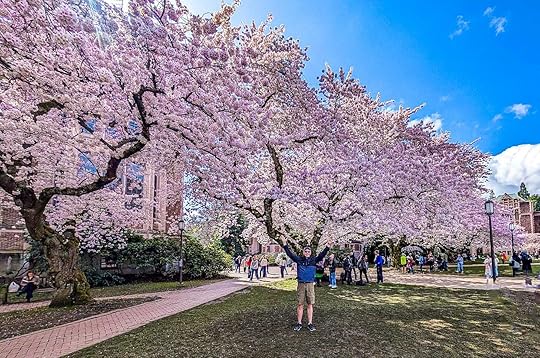 Behold, the ham himself!
Behold, the ham himself!No, he didn’t plan for it.
He merely returned to Seattle for a visit with family and friends, nary any idea that it was cherry blossom season, only to stumble straight into a fantasy of pale pinks, soft whites, and endless confetti showers of floral bliss.
Perhaps that’s a bit over the top, but the cherry blossoms were truly spectacular.
Naturally, once Michael realized his good fortune, he dragged me all over Seattle trying to photograph every cherry tree.
I can’t tell you how many times we stood in the middle of a street, Michael obliviously trying to frame the perfect shot and me praying to the Android gods that I didn’t end up cracked and broken in the grill of an SUV.
 Natural selection at work.
Natural selection at work. I’ll say this for my boy: he is dedicated to his craft.
On to our phototour!
Let’s start with the legendary Yoshino cherry trees of the Quad, short for the Liberal Arts Quadrangle, on the University of Washington campus.

The UW’s trees were most likely planted in a nearby botanical garden in the 1930s and then moved to the UW campus in the 1960s. This puts them in their nineties, old but still vibrant and glorious.
Basically, they are the Rita Moreno, Carol Burnett, and Jane Fonda of cherry blossom trees.

The trees blossom between mid-March and early April, attracting hordes of Instagram influencers seeking validation through likes, comments, and eggplant emojis.
Thankfully, El Divo cares naught about that. Michael, on the other hand…

The cherry blossoms didn’t only attract Instagram influencers.
Families posed for family portraits, UW athletic teams posed for yearbook photos, and a drag queen looked fabulous as she struck a pose.
And then there was Michael demonstrating his enthusiasm for … something. The crowds? His brother-in-law’s awesome shirt?
 Michael with his brother-in-law Craig.
Michael with his brother-in-law Craig. Cherry blossoms, or sakura if we’re being properly reverent, are Japan’s gift to the concept of fleeting beauty.
The Japanese even have a word for the practice of sitting beneath the blossoms and contemplating their transient nature: hanami.
I tried to share this concept with Michael, but all he said was, “You mean just sitting there and not taking any photos? ARE YOU CRAZY?”
Someone here is crazy.

Did you know the famous cherry trees that stand along the Potomac River in Washington, D.C., first arrived in Seattle?
They arrived as saplings on board a ship from Tokyo to the Emerald City — the closest major U.S. port to Japan — then put into rail cars and sent to D.C. in 1912 as a flowering envoy from Japan to the United States.
Here at Michael Takes Too Many Pictures, we provide gorgeous photos and snarky commentary and actual education!
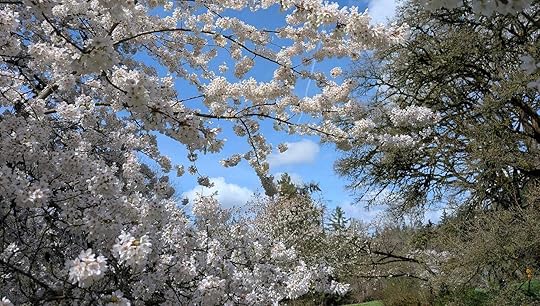
Here’s a bit more cherry blossom history for you.
In 1885, Eliza Ruhamah Scidmore, a very unusual woman, proposed planting trees in Washington, D.C.
She was an accomplished journalist who became the first woman to sit on the governing board of the National Geographic Society. As a travel writer, Eliza ventured into the Alaska Territory and became one of the first tourists to visit Glacier Bay.
El Divo might not want Ms. Scidmore to adjust his aperture, if you get my drift, but he knows a badass woman when he sees one.
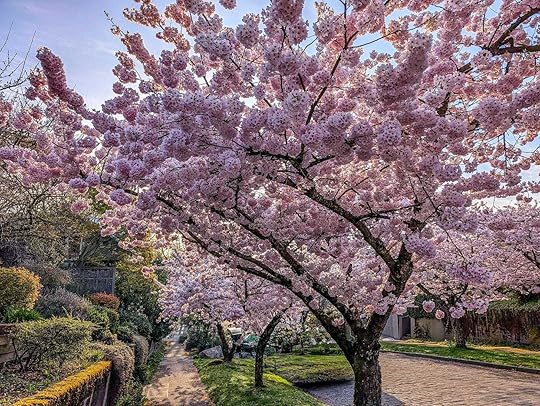
The iconoclastic Ms. Scidmore also visited Java, China, India, and Japan, where she fell in love with the cherry blossom trees.
Upon returning to the U.S., she approached the U.S. Army Superintendent of the Office of Public Buildings and Grounds with the suggestion to plant cherry trees along the Potomac.
He said "Neanche morto," which means “over my dead body,” as we say back in Italy. Every new superintendent for the next 24 years also told Ms. Scidmore to take a hike. It wasn’t until she wrote to First Lady Helen Taft in 1909 that the idea finally took root.
Thanks to Ms. Scidmore's vision, cherry trees bloomed in D.C. three years later.
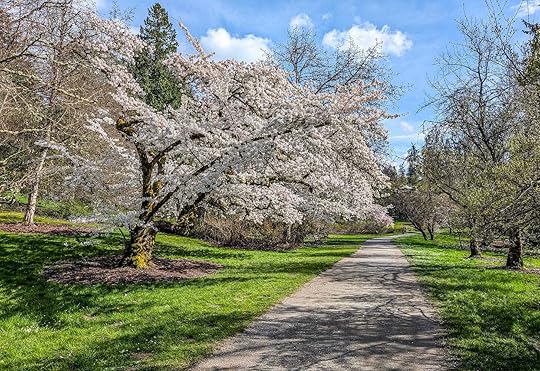
El Divo has nothing but admiration for that kind of determination.
I’m not going to state definitively that the very unconventional Ms. Scidmore, incorrectly identified by the National Park Service as Mrs. Scidmore, was a lesbian.
But if it looks like a cherry blossom tree and blooms like a cherry blossom tree, then it’s probably a lesbian, er, cherry blossom tree.

Poor Seattle had to wait almost twenty more years to get its own cherry trees. But the wait was worth it, as in 1930, Japan sent four thousand flowering trees to the city.
 Not a lesbian — and clearly not a fashion trendsetter — but definitely gay.
Not a lesbian — and clearly not a fashion trendsetter — but definitely gay. Another 95 years passed before Michael spent a week taking the most spectacular photos of Seattle’s cherry trees ever recorded.
(Note: Michael said he would trade me in for the latest iPhone if I didn't say this. I assume it was an idle threat, but it's best not to take chances when dealing with an ego of this proportion.)
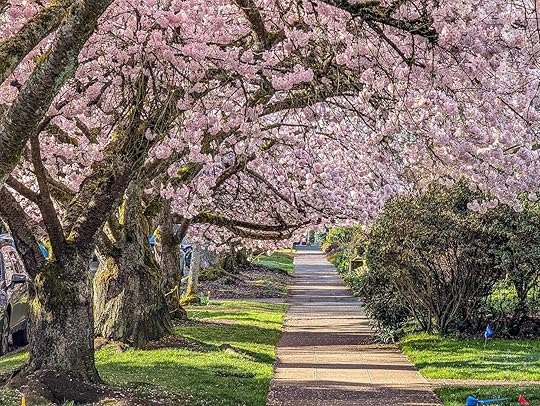
Here’s another interesting cherry blossom fact to impress your friends: The petals are edible and taste like a delicate blend of rose, cherry, and green tea.
The flavor is very subtle, much like El Divo himself.
The petals are sometimes pickled and used in sweets and teas. There’s also a cherry blossom Pepsi for sale in Japan, which I refuse to try because El Divo has standards.

The keen-eyed among you — mostly everyone but Michael — have likely noticed that cherry blossoms can be pink or white.
Some are a blushing pink like a debutante’s first flirtation on an episode of Bridgerton. Others arrive clad in an innocent white while hiding secrets, also like an episode of Bridgerton.
El Divo likes Bridgerton? Of course, he does. Have you not seen Jonathan Bailey? That man is finer than a perfectly cut piece of sashimi at the best Tokyo sushi bar.
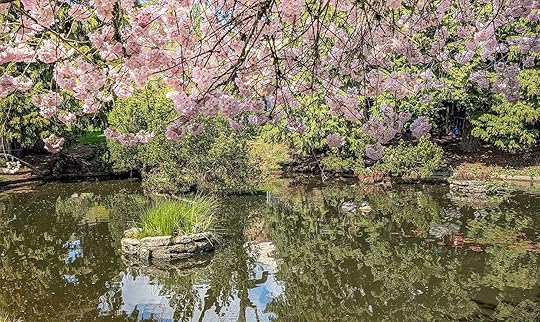
Here’s the thing about cherry blossoms: they never stay. Indeed, their time is brief. That’s the point.
Mono no aware, the Japanese call it — an awareness of impermanence. The heartbreak of beauty that doesn’t last. Which is why Michael’s accidental timing was such a miracle. He showed up, and for a brief, glittering moment, everything aligned.
Serendipity.
And now the cherry blossom season is over.
But Michael and I were there. We saw the beauty and appreciated the mono no aware.
Well, at least I did. Michael was still taking pictures.
That’s okay, though — otherwise, we wouldn’t be able to share our moment of serendipity with you.

If you enjoyed this newsletter, I would appreciate your sharing it with someone you think might also like it.
Michael Jensen is a travel writer, amateur photographer, and novelist. Check out his other newsletter about his travels at BrentAndMichaelAreGoingPlaces.com.
April 3, 2025
A Picture-Perfect Dip into Bath, England
Bath, a small town located in the rolling hills of southwest England, is famous for having once been a Roman outpost built around natural hot springs that, in the 18th century, became a spa town frequented by the English upper crust.
Today, visitors love Bath for many reasons: the Gothic Bath Abbey, the River Avon, and the gorgeous Georgian architecture clad in honey-colored limestone that gives the city its striking look.
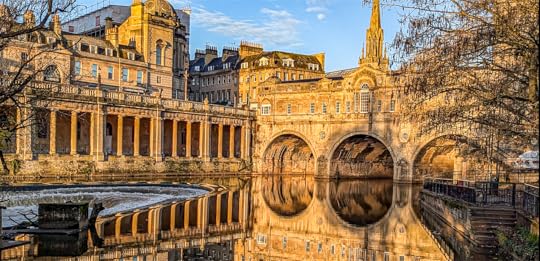 Worth getting up at 5 AM to capture!
Worth getting up at 5 AM to capture!Shall we take a walk through this lovely English town?
Yes? Awesome!
I’m afraid I’ll be your guide this time. No El Divo or imperious dragons, alas. But I have asked Miss Jane Austen — who spent much time here — to share some of her observations about Bath.
Now strap on your walking shoes, and let’s get going — I have a lot of pictures to take!
The River AvonEvery charming European town needs a river, and the River Avon is Bath’s. It lazily winds through this ancient city, offering serene waterside walks, charming bridges, and the occasional swan with attitude.
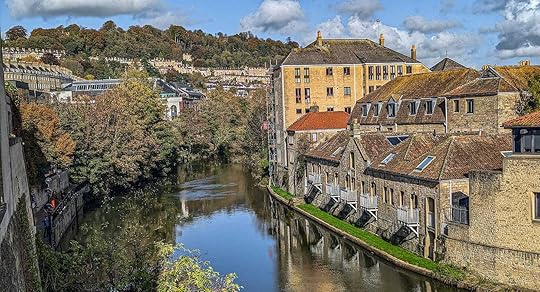
The river provides a lovely backdrop to much of the city. Its still waters reflect the beautiful Bath limestone adorning much of the town.
Don’t be fooled by the river’s placid presence. Devastating floods frequently ravaged the city before floodgates were installed in the 1970s.
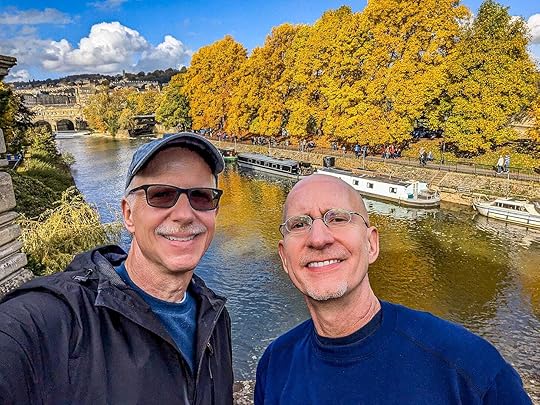
But now the river is the perfect walking companion as you meander through the city.
💡 Miss Austen says: The River Avon, like any proper lady of good breeding, glides through Bath with an air of serene elegance — but pray, do not be deceived, for beneath her placid surface lie depths most unexpected, ready to catch the unwary.
Bath AbbeyOne of the first things you see when arriving in the city is Bath Abbey, a Gothic masterpiece with soaring stained glass and intricate stonework.
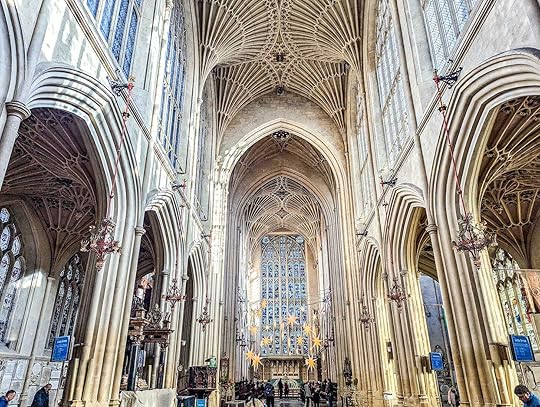
The tower dates back to 1611, and while I am rather “churched” out after eight years of travel, I still recommend visiting it.
Although I mostly went for one reason…
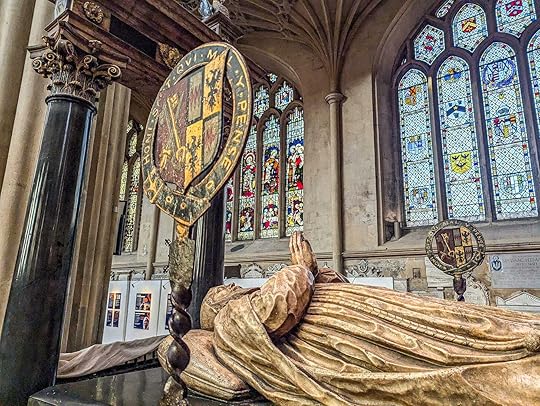
No, not to scout my final resting place.
To climb up the bell tower to get this fantastic view of Bath!
 Worth it!
Worth it!💡 Miss Austen says: A visit to the Abbey shall elevate both one’s spirits and one’s heart rate, for the ascent to the tower is a trial worthy of the pious. But persevere! The reward is a view most pleasing and possibly a newfound appreciation for chairs.
The Roman BathsAs with churches, I have seen many ancient Roman ruins at this point in our travels. The Romans apparently traveled everywhere in Ancient Europe — togas must have been as common a sight as retired Americans in baseball caps are today.
So it wasn’t until my third visit that I ponied up the £24.50 (£27.00 on weekends) to tour the Roman Baths.
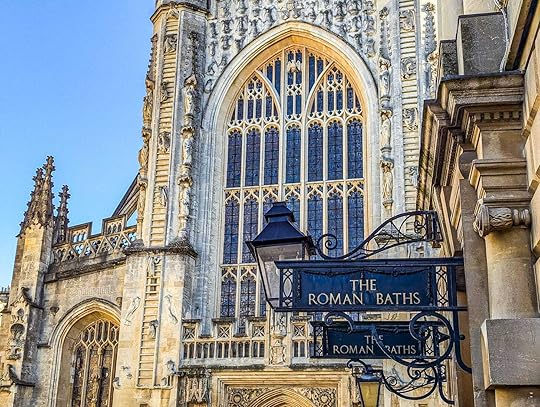
Was I disappointed?
Not in the least! It’s great!
The bathing complex has two levels, the top of which is decorated with various statues.
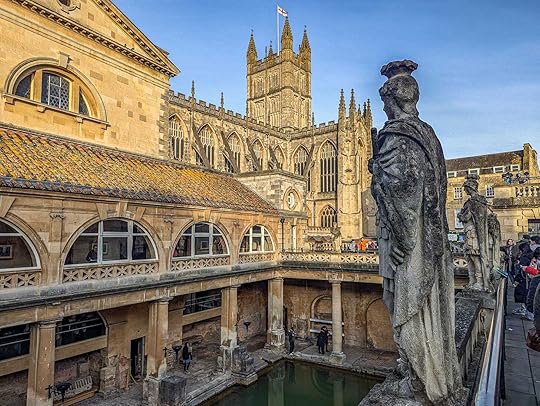
But don’t be deceived: the statues on the upper terrace don’t date back to the Roman era. They were added in 1894, although, interestingly, they include representations of ancient Roman generals, English statesmen, and other famous Victorians from that era.
The jade-green water of the main baths provided the perfect surface to reflect the Bath limestone. Yes, my photographer’s heart was singing!
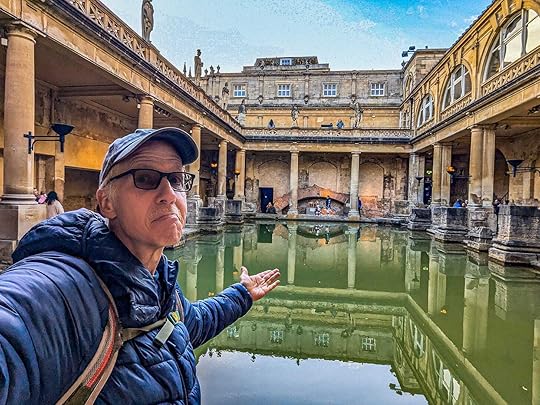
The steaming, mineral-rich waters may look inviting, but don’t try to go for a swim, or you might find yourself fed to the lions. Okay, they’ll probably just politely ask you to leave, but still. Awkward!
The water for the baths comes from rainwater that seeps down through the limestone, where it is heated by geothermal activity to between 69°C and 96°C (156°F and 204°F) before rising again and reaching the baths, where it is typically around 45°C (113°F)
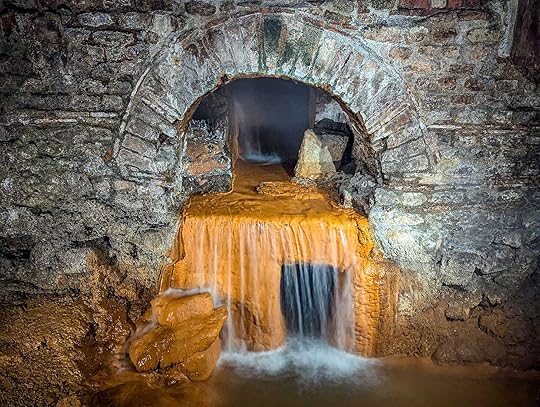 Thermally heated water pouring into the baths!
Thermally heated water pouring into the baths!Be sure to save time for the museum and several recently excavated rooms, including this caldarium.
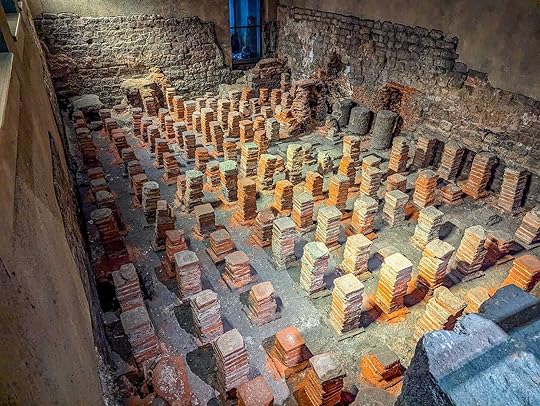 The area under the steam room’s floor is the “hypocaust,” where hot air circulated around these brick stacks that once supported the floor.
The area under the steam room’s floor is the “hypocaust,” where hot air circulated around these brick stacks that once supported the floor. 💡 Miss Austen says: I recently learned that the Romans did not bathe alone but with all their acquaintances, as well as slaves, to tend to them — a most shocking notion to modern sensibilities!
Pulteney BridgeDid you know that Pulteney Bridge is one of only four bridges in the world lined with shops throughout its length?
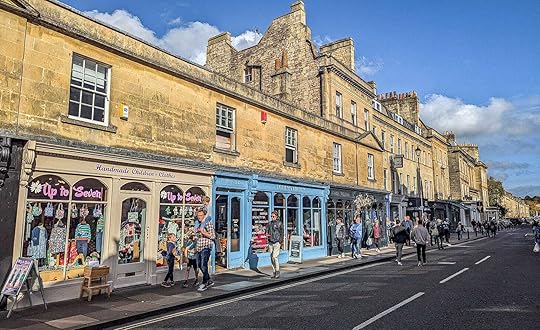 It looks like a street, but it’s a bridge!
It looks like a street, but it’s a bridge!Okay, that wasn’t the most riveting bit of trivia. But that tracks because even though it’s often listed as one of Bath’s better attractions, I wasn’t impressed by ye olde Pulteney Bridge. However, I did get a nice cup of coffee and bun at a coffee shop on the bridge.
That said, it was pretty enough, with the right angle and lighting.
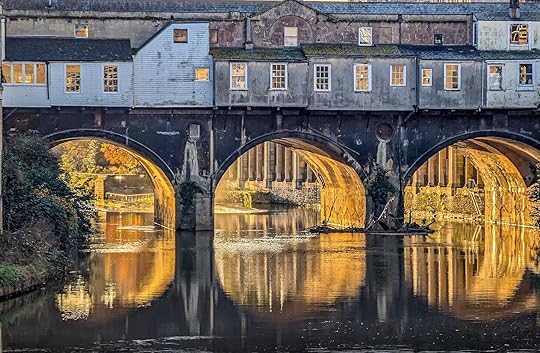
💡Miss Austen says: Unlike our erstwhile guide, don’t partake of refreshments upon the bridge itself. Utilize it to cross the lovely Avon and then patronize an establishment less likely to fleece one like sheep upon the hillside.
The Royal CrescentThe minute I saw a photo of the Royal Crescent's magnificent sweep, I knew I had to see it. And by “see” it, I mean photograph it!
Look at how gorgeous that curved front is!

The Royal Crescent is one of Bath’s most iconic buildings. It is a masterpiece of Georgian architecture, designed by John Wood the Younger and built between 1767 and 1775.

The Royal Crescent features a striking, sweeping curve of 30 terraced houses fronted with Bath limestone.
Here’s a fun fact: Despite the Royal Crescent's uniform appearance, each apartment’s interior is unique, and the different floorplans reflect the preferences of the original owners.

To get a peek at what it was like to live here, visit No. 1 Royal Crescent. Step back in time and wonder how anyone survived without Wi-Fi.
No, seriously! We all used to live that way!
💡Miss Austen says: Such ostentatious displays of wealth are rather unbecoming. Though, I will confess, should someone offer me a residence here, I would not decline.
The CircusThe Circus in Bath, England, was built between 1754 and 1768. It was designed by John Wood the Elder — yup, John Wood the Younger’s dad. Don’t ask me why John Wood the Elder didn’t simply name his kid John Wood, Jr., which would’ve been much less confusing.
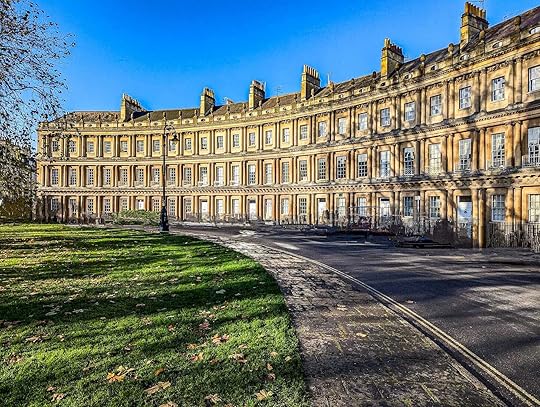
Convinced that Bath had once been a hotbed of Druid activity, Wood designed the Circus to mimic the diameter of nearby Stonehenge. The Circus forms a complete circle, broken only in three places by roads leading into the center.
Wood was also a fan of the Italian architect Andrea Palladio and used Palladian design to draw up his plans. I guess all the Roman ruins already lying around Bath weren’t enough Italian stuff for Mr. Wood.

Wood originally planned to place a grand obelisk to stand in the middle, reinforcing his belief in sacred geometry. However, the obelisk was never built, and over time, trees were planted instead.
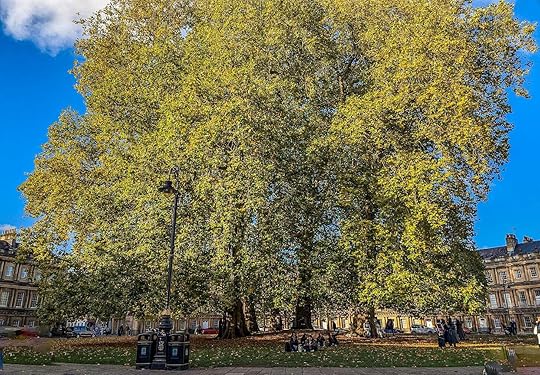
The trees are cool but, well, kinda ruin the visual impact of the Circus.
💡 Miss Austen says: One might suppose that Mr. Wood wished to remind us that life is a circle. Personally, I think it's more like a triangle, often between romantic parties too foolish for their own good. Myself excepted, of course!
Bath is Fake!Now is as good a time as any to tell you Bath’s dirty little secret — the city’s a fake!
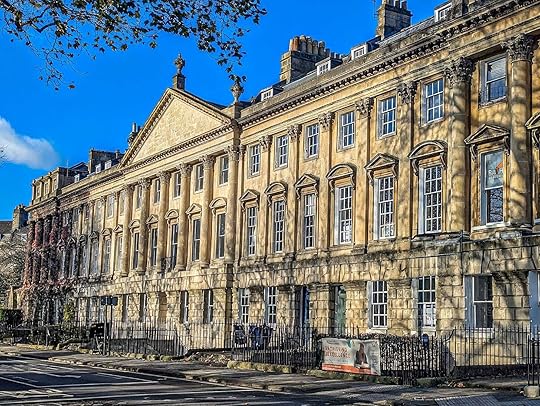
Okay, it’s not exactly fake, but Bath’s elegant look is definitely a cheat! Beneath all of that honey-colored limestone lies either a medieval city covered up or newer construction that looks far less impressive from behind.
In the 18th century, developers wanted a city of elegance without overspending, so they added grand limestone facades to the front while using cheaper materials for the backs and interiors.
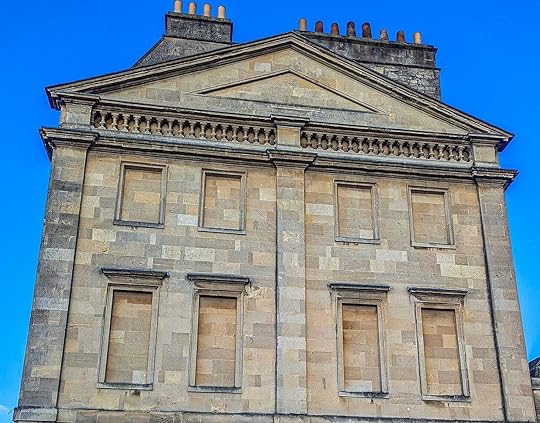 This building has no windows. City fathers just thought a facade of Bath limestone covering the ugly wall behind it was the best way to go.
This building has no windows. City fathers just thought a facade of Bath limestone covering the ugly wall behind it was the best way to go. So when you admire the grandeur of the Royal Crescent or the Circus, just remember: you’re mostly looking at a well-dressed illusion. It’s pretty much the architectural equivalent of a very nice suit hiding a ratty tracksuit underneath.
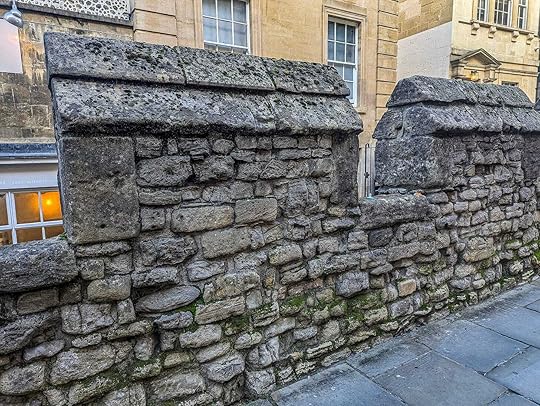 Most of the buildings in Old Town Bath are constructed this way, with cheaper materials hidden beneath limestone facades.
Most of the buildings in Old Town Bath are constructed this way, with cheaper materials hidden beneath limestone facades.💡 Miss Austen says: Nowhere is the genius of British society more evident than in Bath, where even the humblest dwelling may present a face of fine limestone, while behind it lurks something far less refined. It is a principle much admired among the gentry — so long as appearances are preserved, who would trouble themselves with what lies behind?
Bath Skyline WalkBrent and I like few things more than getting out and walking. And when that walk is filled with trees bursting with autumn color and views of a lovely British town?
Brilliant!
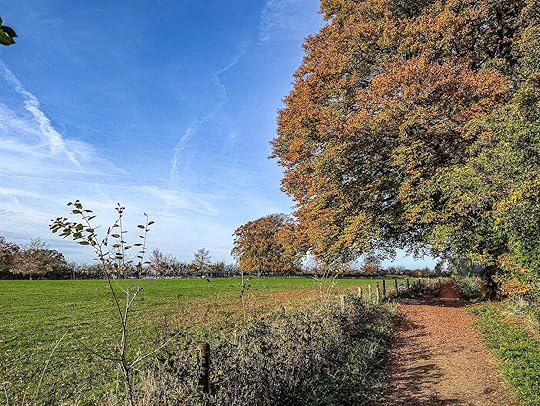
For those who like their history with a side of fresh air, this National Trust trail offers sweeping views of Bath and the rolling countryside.
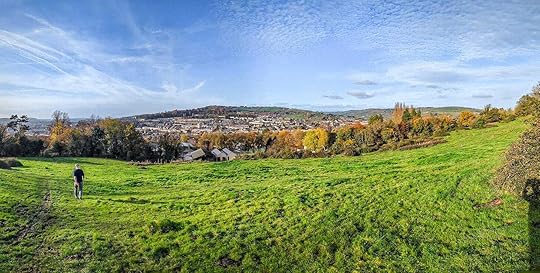
The entire walk is 6 miles (9.6 km) long and takes 3.5 to 4 hours, which is perfect on a crisp fall morning.
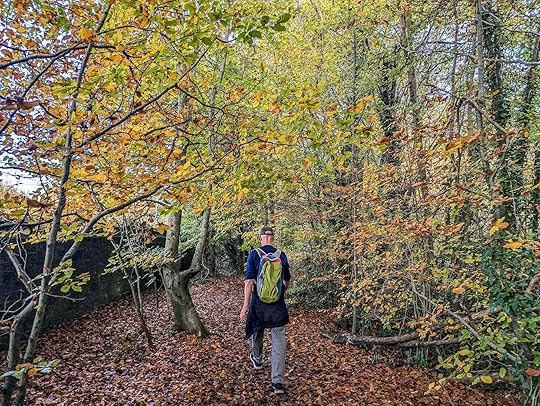
You’ll pass through woodlands, the University of Bath, and sheep grazing, harkening back to Bath’s day as a center of the wool trade.
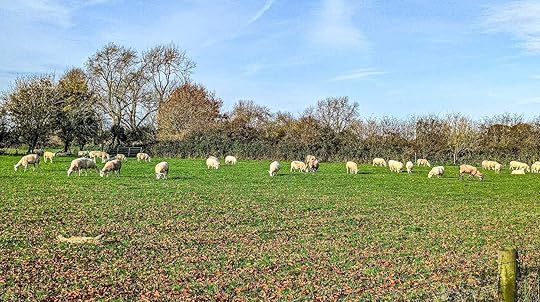
A little exertion is required, but the payoff is pure Jane Austen novel territory—minus a brooding Hugh Grant with his tousled hair.
💡Miss Austen says: It is a truth universally acknowledged that a strong constitution thrives on a good long walk — nowhere better than the Bath Skyline, where fresh air and fine views uplift the soul. Even in the rain, one gains either the virtue of exercise or fortitude — particularly when sliding gracefully down a muddy path.
Sham CastleWhen doing the Bath Skyline Walk, keep your eyes peeled for one of the stranger things you’ll encounter — a fake castle!
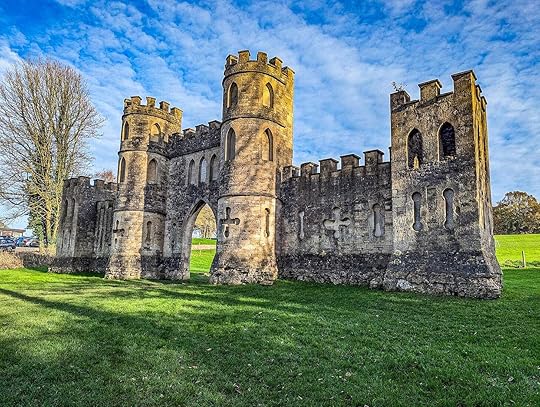
It’s not really a castle. It’s a type of “folly,” which, in this case, means a rich dude had more money than was good for him. The dude in question is Ralph Allen, who had the castle built in 1762 to improve his view because, you know, rich people.
💡 Miss Austen’s Special Tip: There is no sight more off-putting than a gentleman with too much wealth and too little occupation, for he will invariably set about building something utterly unnecessary. Thus stands Sham Castle — a monument less to defense than to the enduring truth that boys with toys do not grow up, they merely acquire more immense playthings.
The Kennet & Avon CanalOne of the delights of travel is discovering something you have never heard of but that you absolutely fall in love with.
That perfectly describes this wonderful waterway Brent and I stumbled upon while perambulating around Bath. (Uh oh — I’m starting to sound like Miss Austen myself.)
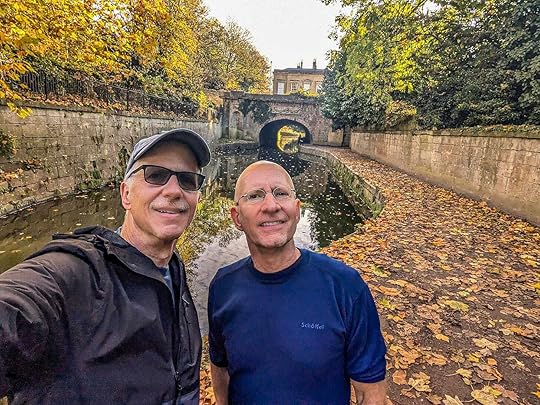
That 87-mile-long canal, constructed between 1718 and 1810, has 105 locks and links London with Bristol.
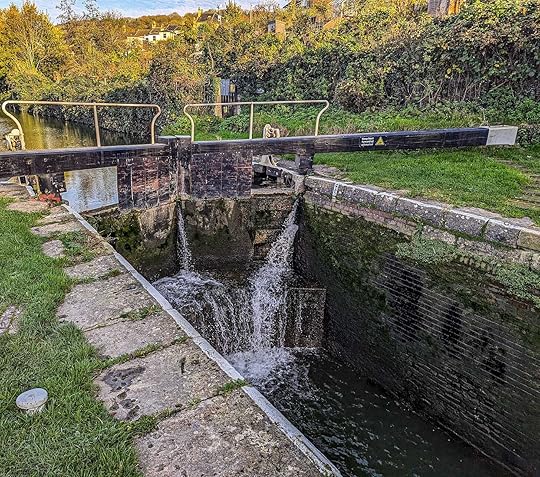
The canal fell into disrepair after the railroads appeared. Thankfully, many years later, volunteers realized the hidden gem in their midst and restored it.

It’s now very popular with cyclists and boaters. The canal is filled with colorful narrowboats, which you can rent and sail along its length.

💡 Miss Austen says: A stroll along the canal is most agreeable, but beware! The temptation to abandon city life and take up residence in a narrowboat is strong, though one suspects the reality is less romantic than the notion.
That’s it for this month’s issue of Michael Takes Too Many Pictures!
If you enjoyed it, please share it with a friend. Or an enemy! I’m desperate and not picky.
Next month: The return of El Divo!
If you enjoyed this newsletter, I would appreciate your sharing it with someone you think might also like it.
Michael Jensen is a travel writer, amateur photographer, and novelist. Check out his other newsletter about his travels at BrentAndMichaelAreGoingPlaces.com.
February 19, 2025
My Sarcastic Gay Camera Takes You On A Tour of Italy's Cinque Terre
Buongiorno! And please note that this greeting is pronounced differently than it’s spelled. For you plebians, it sounds like “Bonjourno.”
Yes, you’re coming along on another one of Michael’s photographic journeys, but no, Michael will not be your guide. I shall be! And I’m much more entertaining than the silly dragon who dragged you around Bangkok.
Who am I, exactly? I am Michael’s Pixel 9 XL Pro — the Dom Pérignon of cameras, the Meryl Streep of megapixels.
I’m also the one who actually does all the work taking these photos he’s so proud of. Naturally, I get none of the praise.
Whatever. I don’t really care. I am about the work.
My name? I have many. You, however, may call me “El Divo.”
Today, you shall accompany me as we visit the jewel of Italy’s Ligurian coast, the Cinque Terre.
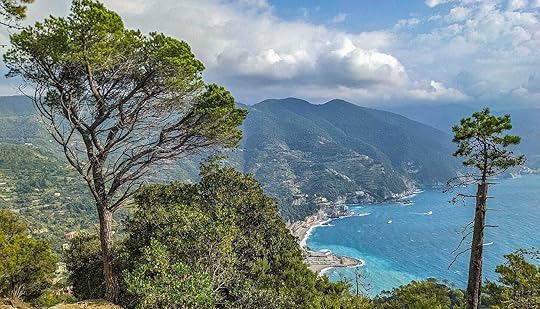
Ah, Cinque Terre! You are bellissimo! Magnifico! Beyond compare, even when overrun by the sweaty hordes Rick Steves unleashed upon your pastel-painted villas.
Five breathtakingly picturesque villages clinging to the rugged Italian coastline, dripping with charm and history — and gelato dropped by screaming brats with no business being here.
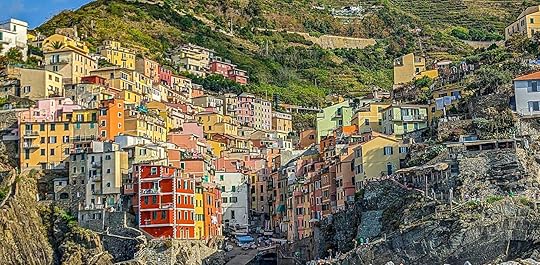
It's a paradise for any serious photographer with a good eye and a modicum of talent.
Sadly, I find myself in the hands of this hack named Michael Jensen, a guy dressed like a tourist dad on laundry day. A guy who wouldn’t know an f-stop from a bus stop.
Never mind — let us begin!
Vernazza – Sunrise, Umbrellas, and an Overcaffeinated PhotographerDid you know Michael is an early bird? Well, he is. And he dragged my ass out of bed before the crack of dawn to take pictures.
Sigh.
Look at him with that striped shirt and baseball cap. He’s where fashion and style go to die.
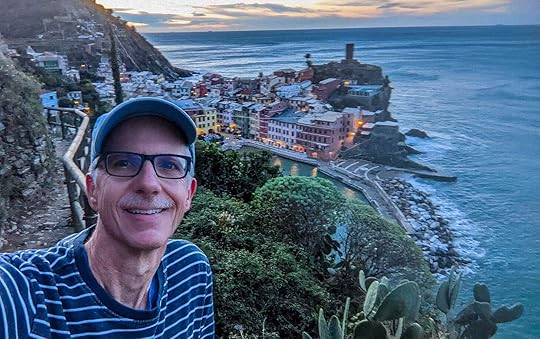
We begin in Vernazza, which — fun fact! — dates back to at least 1080 AD and was once a key naval base for the Republic of Genoa.
Okay, the view here is pretty cool, even if the only sunrise I want to see involves tequila.
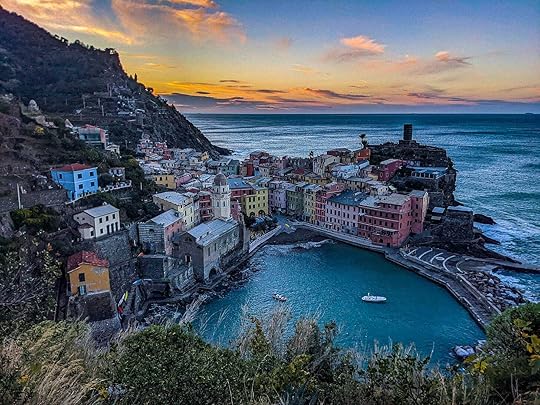
Together, we walk back down to where the colorful umbrellas dotting the harbor create a picturesque scene that even I, Michael’s long-suffering camera, admit is lovely.
But Michael? He’s in a frenzy.
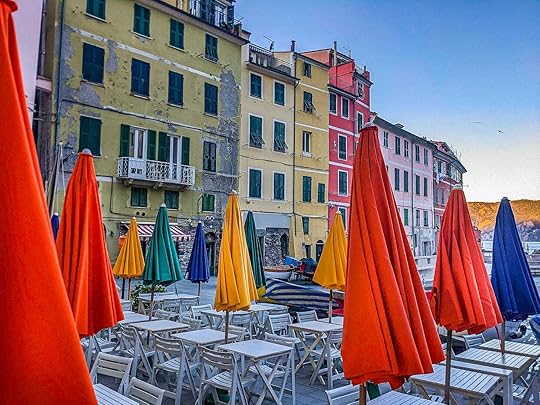
“Golden hour, golden hour!” he chants, leaping about, snapping shots of every fishing boat, every seagull, every glistening wave.
Seriously, it gets as old as all the Superman reboots.
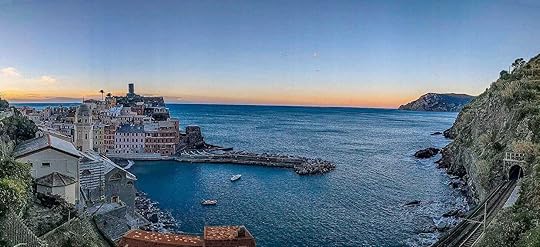
Michael is finally ready to move on, and it’s a good thing because my shutter button is about spent — and I don’t mean that in a fun way.
Monterosso al Mare – The Ed Sheeran of the Cinque TerreNext, we traipse to Monterosso, the largest of the five towns and the only one with a proper beach.
It's also home to Il Gigante, a crumbling 14-meter statue of Neptune attached to Villa Pastine. Il Gigante looks like he’s suffering a horrible existential crisis, no?
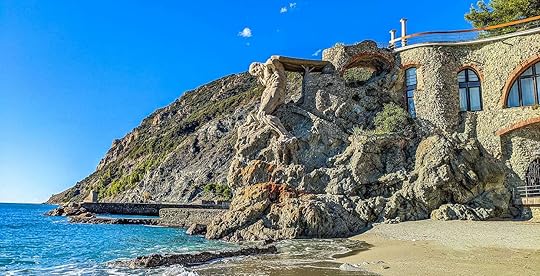
Honestly, same. Is this all life has for me? Being lugged around the world by, well, this big lug?
Michael, amped up on three espressos and two chocolate croissants, has no idea what I feel as he races around, trying to find the perfect picture that “captures” Monterosso.
Yes, there are some plazas with those pastel-colored buildings.
Honestly, though, Monterosso is the least interesting village of the five.
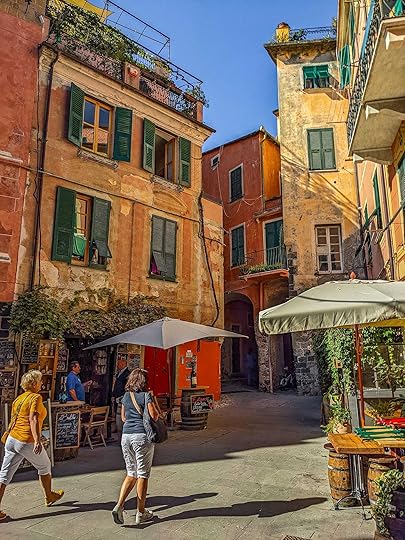
It’s the Ed Sheeran of the Cinque Terre — sure, he’s a great singer/songwriter, but he’s got none of the panache of Elton John, Freddie Mercury, David Bowie, or Boy George. Where are the bright colors? The dramatic vistas? Unforgettable seascapes?
Really, the best thing about Monterosso is the lovely beach, something none of the other villages have.

Farewell, Monterosso. We’re off to Corniglia.
Corniglia – Up, up, up!We hop on the train and arrive at Corniglia, the only Cinque Terre town without direct sea access.
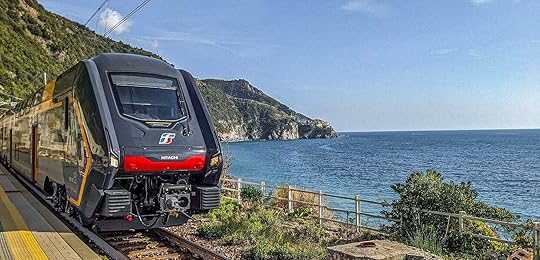
The smallest of the Cinque Terre villages sits 100 meters above the water, and there are only two ways to reach it — a shuttle with a long line of people.
Or 382 steps.
Michael insists on climbing them because: “We don’t have a minute to waste!”
He’s rather stressed because it looks like some weather is headed our way. Michael can be very neurotic about the weather. Heaven forbid if our little Prince of Pictures doesn’t have perfect lighting all day.
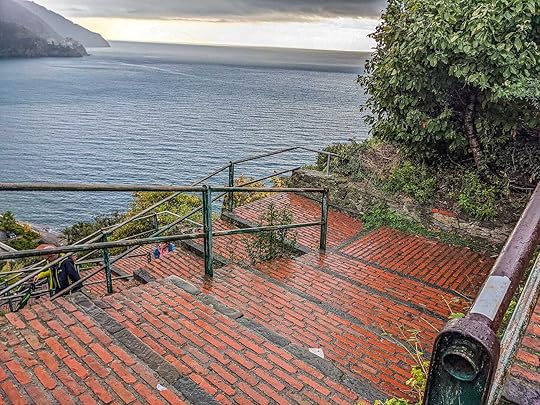
The name Corniglia likely comes from a Roman family that once owned vineyards here.
Alas, the rain does roll in, and thankfully, Michael decides to seek shelter. I am water resistant, but I appreciate that he doesn’t push it.
On the other hand, it’s less out of concern for my feelings than his worrying about squeezing every precious photo out of me possible.
Michael glumly sips his sixth espresso, waiting for the rain to let up, when a man walks by with a colorful umbrella.
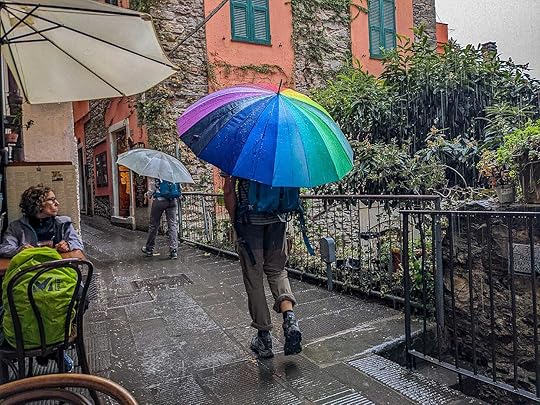
My erstwhile owner squeals like a Swiftie attending her first concert and leaps to his feet, snapping away like a madman. “It’s like something from a classic Italian film!”
To be fair, the picture he gets isn’t half bad.
Then we are off again. As if apologizing for not giving us more to work with, the skies clear as we leave, and Corniglia sends off with a gorgeous final photo.
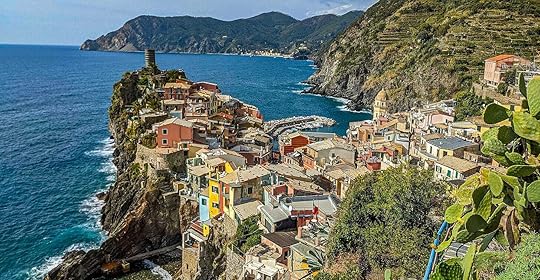 Riomaggiore: Rhymes with Chicken Cacciatore
Riomaggiore: Rhymes with Chicken CacciatoreGeographically, Manarola is the next village, but we skip it for now. Michael has already scouted the villages and decided Manarola will have the best sunset.
Instead, we head for Riomaggiore, whose name comes from Rivus Maior — the river that once ran through it.
Michael decides our journey needs a musically-themed soundtrack and starts singing the most Italian thing he can think of — “That’s Amore” — belting out the line “When the moon hits your eye like a big pizza pie, that’s amore!” over and over again.
I seriously cannot believe thousands of you subscribe to a newsletter written by this ham.
Anyway, Riogmaggiore is the steepest of the five villages, with vineyards clinging to the sides like mountain goats to Italian Alps.
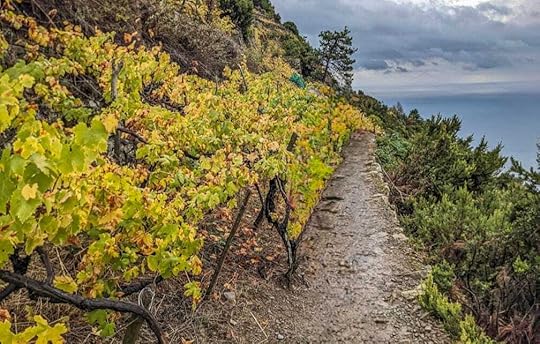
The view as we hike is spectacular, but does Michael take a moment to soak it in? Of course not. He’s too busy photographing every grape leaf, every trellis, and every damn rock that catches his eye.
Riomaggiore comes into view — and it’s a long way down. If Michael drops me trying to get this shot, I swear I will return from the great recycling bin and haunt him to oblivion.

Michael hurries down the steps, terrified we won’t return to Manarola before sunset. Well, we definitely won’t make it back in time if the fool breaks his neck.
Soon we enter Riomaggiore and it’s lovely.

The pastel buildings tumble to the sea like a box of overturned macaroons. Michael gasps, “The colors!” like a toddler seeing fireworks for the first time.
Meanwhile, a group of attractive Italian men dive into the water, their sun-kissed bodies glistening. I take them in, gauging the composition, the lighting, the abs.
“Am I a gay camera?” you ask. Are you only figuring that out now?
Speaking of which, I Am a Camera is the Broadway play adapted from Christopher Isherwood’s 1939 novel Goodbye to Berlin, which was also later turned into a musical, the Broadway hit Cabaret, which was adapted again into the 1972 film starring Liza Minelli in her Oscar-winning role as Sally Bowles.
I’m not just a gay camera — I am a gay camera.

Anyway, Michael? He’s too busy documenting the fiftieth laundry line of the day to pay more attention to the hotties right in front of him.
What is it with Americans and taking pictures of drying laundry anyway? If I didn’t know better, I’d assume Americans think Italy’s main attraction is being the world’s largest outdoor laundromat.
Manarola – The Perfect Shot
Frantic, Michael hurries on, terrified we’ll miss the sunset in Manarola.
We race up the steep stairs, then down again, until we catch our first glimpse of Manarola, possibly the oldest of the five villages.
“This is it,” Michael whispers, awed. “The perfect shot.” As if we haven’t taken four hundred already.

Manarola was founded in the 12th century, and its name may have been derived from Manium Arula, which means “small temple of the dead.” Either that or “big wheel,” which seems pretty confusing
You’d think linguists would’ve figured that out by now, but Italy has a lot of history to sort out.
Regardless of the name, this place is a riot of color, all pastel buildings stacked precariously on cliffs.

I want to linger on the image, imagining myself with, oh, Zendaya maybe, doing the American-romantic-comedy-set-in-Italy thing. Not Lost in Tuscany but…Confused in the Cinque Terre?
Okay, the name needs work.
Anyway, she’s an accident-prone expat who buys a crumbling hotel here and welcomes a curmudgeonly American tourist played by one of the hotties from Challengers — and promptly proceeds to melt his heart.
Okay, the plot needs work too.
Meanwhile, Michael is scurrying around like a demented crab, taking close-ups of — what? A boat that was probably literally put there for people to photograph!
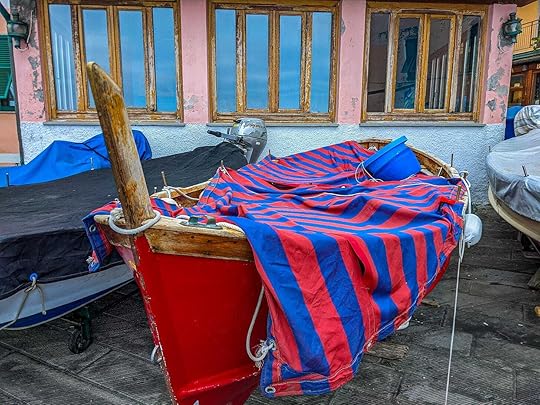
The golden hour is approaching, and Michael is apoplectic, trying to get every shot. To be fair, the golden hour glow really does work its magic.
I’ll allow it.

As the sun disappears behind the cliffs, I begrudgingly admit that Michael captures magic through me — even if he really does take too many pictures.
Night falls swiftly as the moon climbs over the horizon, and the lights of Manarola flicker to life, making everything more magical.

Once again, Michael starts singing, “When the moon hits your eye like a big pizza pie, that’s amore,” but softly this time. Instead of being corny, it’s actually lovely.
He might be a badly dressed dork, but he’s my badly dressed dork.
If you enjoyed this newsletter, I would appreciate your sharing it with someone you think might also like it.
Michael Jensen is a travel writer, amateur photographer, and novelist. Check out his other newsletter about his travels at BrentAndMichaelAreGoingPlaces.com.
January 24, 2025
Through the Dragon’s Eyes: A Journey Through Bangkok's Chinatown
Why do you disturb my slumber, foolish mortal? Have you no respect for ancient beings such as myself?
You truly do not know who I am?
I am the Dragon of Yaowarat! Guardian of secrets, keeper of stories, and silent witness to centuries of transformation.
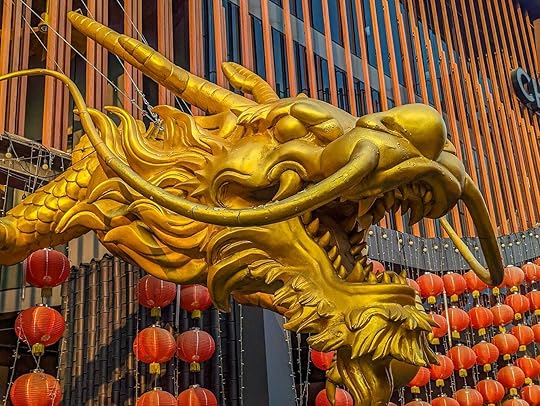
I see you’ve come to ask me to guide you through Bangkok's Chinatown — the colorful, chaotic, beating heart of Chinese Thailand.
You would do well to remember that Chinatown is no ordinary place — it is a vortex of chaos, mystery, and enchantment all swirling together throughout time.

Wouldn’t you prefer the glossy, sterile embrace of one of Bangkok’s glittering malls?
No? So be it. Then climb upon my back so we may be off!

Ah, but we have forgotten something. The price for my time. You didn’t think I did this for free, did you?
At the end of our trip, you shall answer my riddle. If you answer correctly, you may walk away.
If not, I know what I shall feast on tonight.
Here is your riddle.
Born of earth and kissed by sun,
A golden gem, home to one.
On snowy bed, with sweetness dressed,
Name me now, and pass the test.
I see you tremble in fear for your life, as you should. As a reward for your bravery, I give you this clue: You shall see the answer to my riddle on our journey.
Now we are off!
Let us begin where all roads converge: Yaowarat Road. This, many say, is the lifeblood of Bangkok’s Chinatown.
In your simple tongue, it is called the "Royal Road," a name gifted by King Rama V upon its grand unveiling in 1891. A fitting title, is it not, for a path so worthy of majesty?

But to those who truly understand its essence, it is also known as Dragon Road. Do you know why?
Some say it is because Yaowarat coils and twists through Chinatown like a dragon as mighty as myself.

But the reason is much more than that.
I roamed these lands long before King Rama V laid his plans for his grand boulevard. We dragons arrived with the Teochew Chinese, who crossed vast oceans to find a new home.
Remember this: Our spirit imbues everything here. To walk these streets is to walk among echoes of the past, where every stone, every alley, hums with untold stories.
Now, I shall show you a hallowed place where the wisdom and power of the dragon are known.
Hold on! Here we go!
Don’t be fooled by Wat Mangkon Kamalawat’s modest exterior. Trust me, the inside befits a dragon.

I don’t suppose you know what that name means, do you? Don’t look so nervous, for your life does not depend upon that answer. Well, probably not.
It means “Dragon Lotus Temple.”
Surely, you know the dragon is no ordinary beast. We are divine bearers of power, luck, and boundless courage. This temple gleams in red and gold, for these sacred hues, when united, summon the pinnacle of prosperity and fortune.
A fitting tribute to one such as I, wouldn’t you agree?

Next, we visit a place for what you humans most worship.
Welcome to bustling Sampeng Road! This is Chinatown’s underbelly, where men and women pray at the altar of money.

Look at how you crowd together! Look at how you barter and bargain over a few piddling baht!
I remember when rice paddies glinted here in the sun like emeralds. Now it’s nothing but your scooters going “brrrrrrrrrmmm” and fouling the air.

Thankfully, not all the scents here are of sweating humans and stinking scooters. Breathe deeply and savor the earthy whisper of turmeric, the sweet allure of cinnamon, and the fiery bite of peppers. A feast for the nose, is it not?

Your kind used to sell other delights here, for Sampeng Road was once known as “Sin Alley.” Opium and fleshly pleasures in brothels were bought and sold in this shadowy place.
Since you seem so interested in riches, I know where to take you next. Grab hold, for we will come face-to-face with Phra Phuttha Maha Suwanna Patimakon, Thailand’s most valuable treasure.
Wat Tramit was once a humble temple visited by only a few. Now, it is of great importance.
Any guesses why?

No, it is not these lovely golden bells. But it does have much to do with gold. Or should I say it has to do with “much gold?”
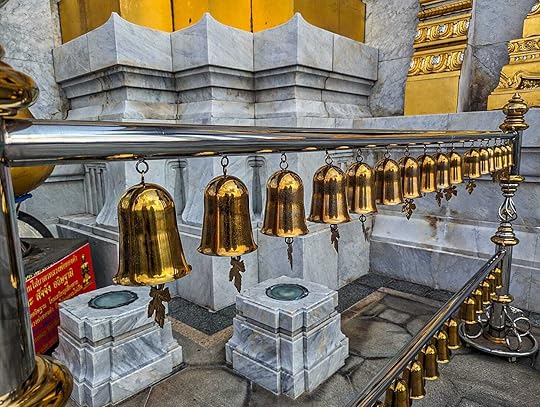
Humble yourself before Phra Phuttha Maha Suwanna Patimakon, known as the Golden Buddha to the insignificant likes of you.

The Golden Buddha stands ten feet tall and boasts a life of over 700 years — yes, even older than I. And before you ask, it is worth half a billion dollars in your tawdry currency.
What’s that? Hungry, are you? So am I! But I shall wait until tonight, keeping my hunger sharp for when your wits falter on my riddle.
Are you one of those fussy types who fear street food for its rumored Bangkok Belly? No? Ah, good! At least you’ve got some courage.

I’m sure you will find something to your liking here. But beware, for this food is often too spicy for the likes of you.

Be sure to have some mango sticky rice. If this is to be your last day on this earth, it should have at least a little sweetness to it.

You shall take the next part of your journey alone, for I have other matters that demand my attention. Seek the giant fig tree in Talat Noi. You will know it by the vivid colors wrapped around its trunk.
But a warning: do not even think of sneaking away to avoid my riddle. The mighty Dragon of Yaowarat sees all and will find you wherever you hide.
Ah, you have reached our sacred Bodhi tree. Tell me, wanderer, what do you make of it?
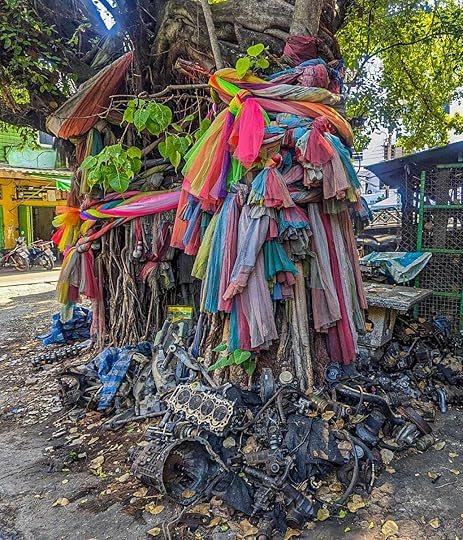
Do you know why the Bodhi tree is sacred to Buddhists? It is said that the Buddha meditated beneath one for 49 days to attain enlightenment.
I suspect it would take you much, much longer.
And what of the scraps of cloth tied around the tree? They honor the spirits dwelling within and serve as a warning to all who pass by: this tree is sacred and must not be harmed.
You now find yourself in Talat Noi, one of Bangkok’s oldest quarters.
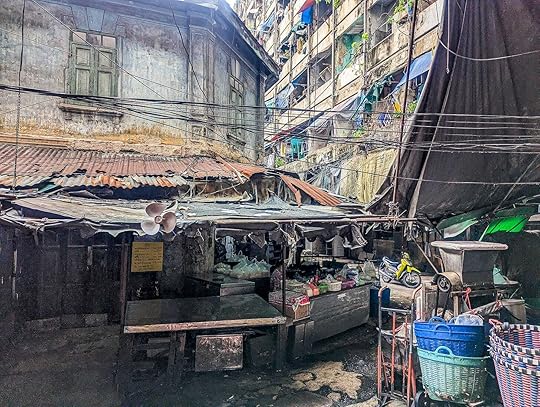
Portuguese traders were the first to settle here when it became Bangkok’s first port. Since then, Talat Noi has embraced many peoples: Vietnamese, Khmer, and most notably, the Chinese.
Ah, you’ve spotted the abandoned car nearby. No doubt, like so many of your kind, you’ll feel compelled to immortalize it in a photograph. Humans and their peculiar fascinations.
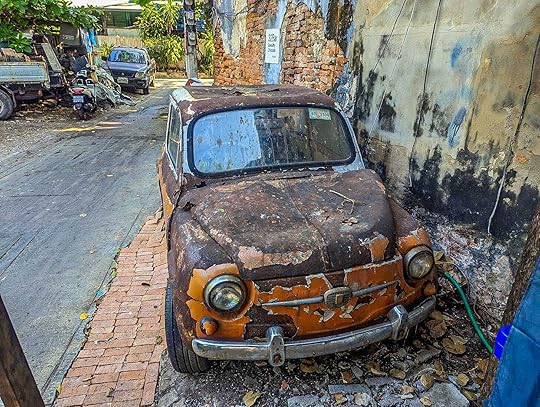
It is known as the “Antique Turtle Car” and was once a shiny Fiat 500. No one knows who left it here, but its presence is fitting, for Talat Noi has long been associated with automobiles, especially by Chinese workers refurbishing old car parts.
That is why you will see huge piles of engines, carburetors, and more on the streets.

But car parts almost as old as me aren’t the only thing in Talat Noi.
This old man barters mangoes you might enjoy.

And here is a tribute to you mortals and your foolish belief in love.
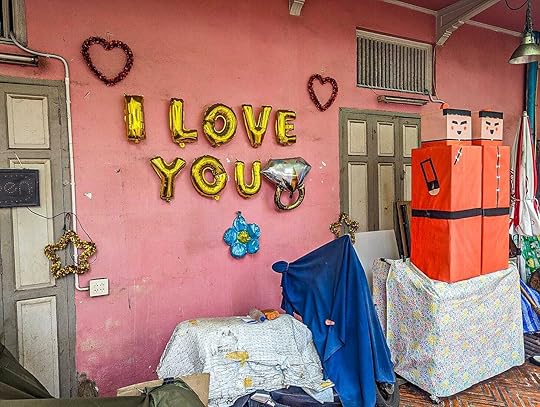
Sweet but these young lovers will be dust while I am still young.
Chinatown teems with what you call “street art” — yet another fleeting attempt by you short-lived mortals to etch your presence upon a world that scarce remembers you when you’ve passed.
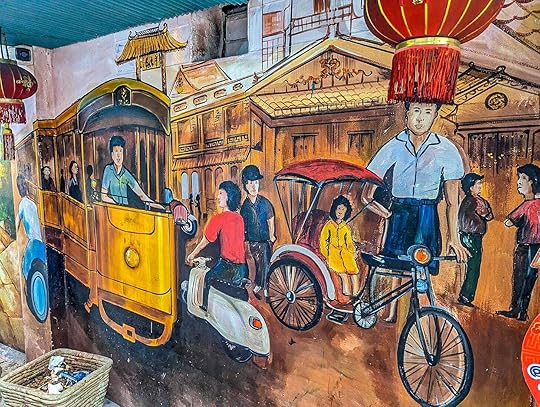
Our day is winding down, and I have something much more memorable to show you.
Behold Leng Buai Ia Shrine, the oldest Chinese temple in all of Thailand, standing proud since 1658.
Naturally, it is adorned with the mighty dragon, a fitting symbol of power and protection. Such figurines grace nearly every corner your eyes can find.
On the walls, on the columns…
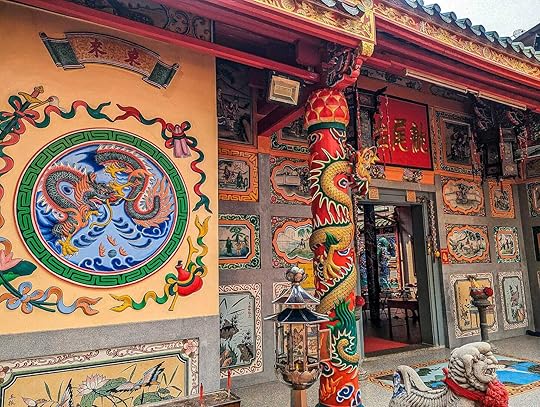
On the roof…

And outside, a magnificent column with a dragon wrapped around it.
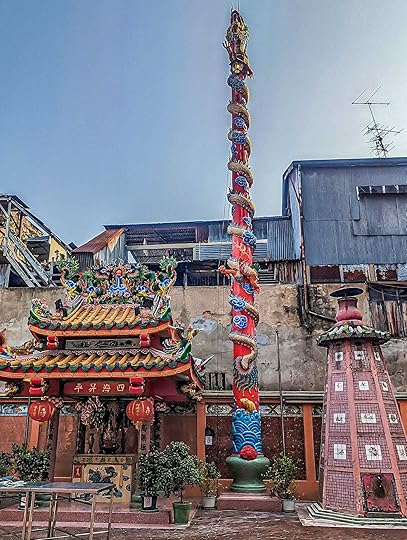
You should enter, but our time grows short. Climb aboard. Use our journey back to Yaowarat Road wisely, for you owe me an answer to my riddle.
Ah, we have returned.
Do not be deceived by the bustling chaos of this street. If you fail to answer my riddle, there will be no escape. I shall devour you — and your fellow mortals shall be unaware, seeing nothing but more bustle and glare.

Here is the riddle one more time.
Born of earth and kissed by sun,
A golden gem, home to one.
On snowy bed, with sweetness dressed,
Name me now, and pass the test.
All right, foolish mortal. I showed you the glorious heart of Chinese Bangkok, now you must pay the price.
Give me my answer, or your life will be forfeited!
Mango sticky rice? Are you sure? Good, because that is correct!
There is much the Dragon of Yaowarat didn’t show you today. For the answer to another riddle, I will give you another day.
No? You would rather explore on your own? Perhaps you are wiser than I thought.
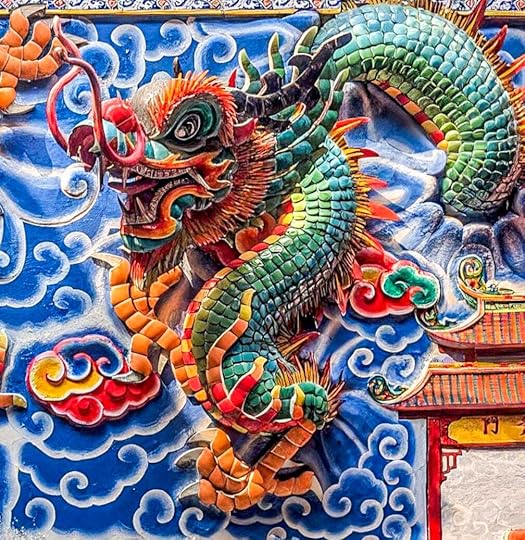
If you enjoyed this newsletter, I would appreciate your sharing it with someone you think might also like it.
Michael Jensen is a travel writer, amateur photographer, and novelist. Check out his other newsletter about his travels at BrentAndMichaelAreGoingPlaces.com.
December 27, 2024
2024 in Twenty-Four Pictures
My Adobe Lightroom Photo app says it is currently storing 18,053 photos that I took in 2024.
That’s not the total number of photos I took this year — only the ones I liked well enough to edit and save. The actual number of pictures I took is probably closer to 100,000.
Given the name of this newsletter, that shouldn’t exactly be a shocker.
 Some of the photos that didn’t make the cut.
Some of the photos that didn’t make the cut. So choosing which photos to include in the first-ever end-of-year Michael Takes Too Many Pictures newsletter has been hard as hell.
Seriously, people, I have been suffering!
I finally settled on the following 24 pictures from 2024 that speak to me for one reason or another and that I hope you enjoy.
Please note that they’re not in any chronological order.
BRISTOL, ENGLAND
November 20, 2:21 PM

Bedminster is a “transitional” neighborhood in Bristol. This means it’s a bit gritty, mostly working class, and isn’t the sort of place most tourists bother with.
Eight years ago, I wouldn’t have bothered either. Now these are some of my favorite places to explore because I think they offer more than the typical, curated “tourist” experience.
WHALE BEACH, AUSTRALIA
January 12, 6:09 AM
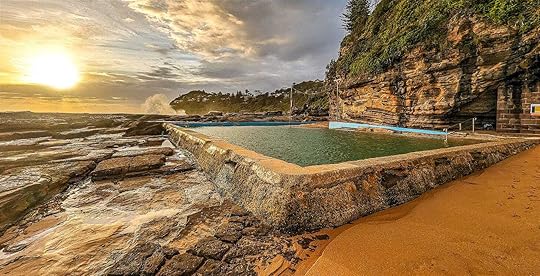
A secret to happiness? Swimming in an Australian rockpool as the sun is rising!
VALENCIA, SPAIN
March 18, 1:47 PM

Valencia, Spain’s Las Fallas Festival is fantastic for many different reasons: the incredible papier-mâché sculptures, street parties, the mascletàs, and especially La Crema, the night when the sculptures are burned in an orgy of fire.
But mostly, Las Fallas is about family and friends coming together to celebrate traditions that have bound this community together for centuries.
ISAFJÖRÐUR, ICELAND
August 3, 12:38 AM

Whenever Brent and I are out walking or exploring, I always trail behind because I’m stopping to take picture after picture.
This means I end up with a lot of photos of, well, his bum. I did it at first as a joke, but now I’ve got so many photos of Brent’s bum bopping around the world I could devote an entire newsletter to that worthy topic.
Hey, that’s a great idea!
REINE, NORWAY
October 3, 11:57 AM
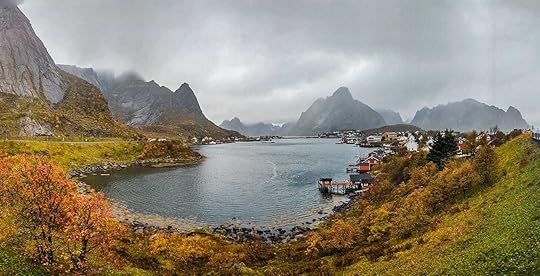
My tour of Norway’s Lofoten Islands allowed only me thirty minutes in the picturesque village of Reine. To get this picture, I had to leap off the tour bus and run like hell to the bridge with this vantage point.
But come on: it was worth it.
BATH, ENGLAND
November 11, 3:45 PM

Some pictures are taken after carefully considering every element to ensure the best composition. Others are snapped in a huge hurry as I chase after Brent.
Any guesses which was the case here? (Hint: I had about three seconds to take it!)
WHALE BEACH, AUSTRALIA
January 12, 8:25 PM
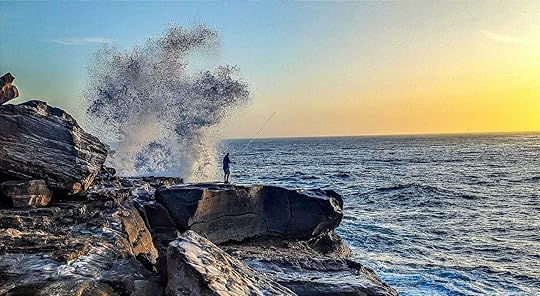
Sometimes, timing in life is everything. For instance, I got this photo, and the fisherman didn’t get swept off the rocks.
BATH, ENGLAND
November 11, 8:33 AM
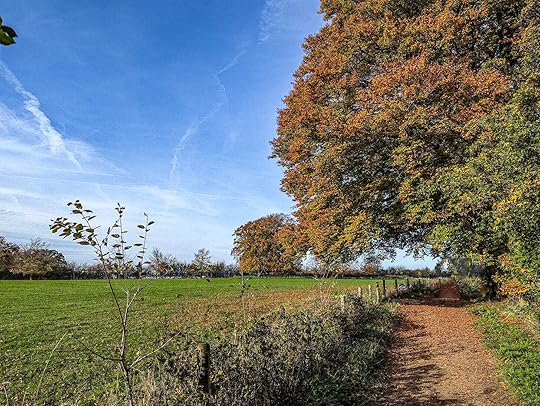
I devoted an entire newsletter to October, my favorite month because I love autumn colors. I hope you’ll forgive me for sneaking in one more photo of the best time of the year.
BRISTOL, ENGLAND
November 20, 9:28 AM

A barista I befriended in Bristol told me about these unusual trees in a nearby park. And he was right: they made a great picture.
BALAT, TURKEY
April 12, 7:03 AM

Our time in the Istanbul neighborhood of Balat was challenging for many reasons. But it also had aspects I loved. Elegant decay! Brightly colored buildings! And, of course, cats.
And this photo has all three.
BRISTOL, ENGLAND
November 20, 1:32 PM

Why can’t every street be as colorful as this one in Bristol? I think if there were more streets like this, the world would be a better place.
FETHIYE, TURKEY
May 2, 7:20 AM
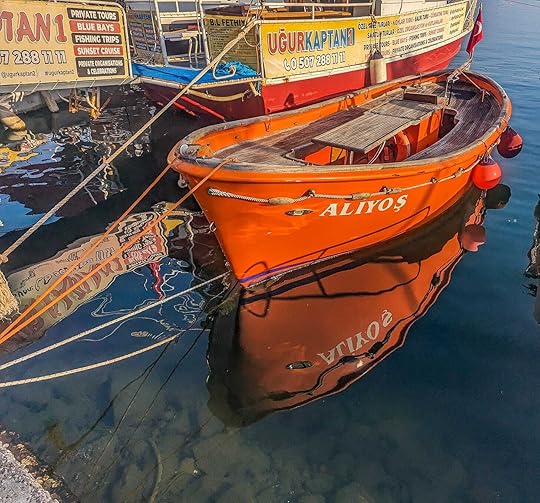
The day I took this picture in Fethiye, Turkey, I was feeling very reflective.
Sorry, I couldn’t resist!
BALAT, TURKEY
April 21, 6:02 PM

Our apartment in Balat, Turkey, was disappointing. But the view we had of the Golden Horn was astonishing.
COPENHAGEN, DENMARK
September 18, 4:00 PM

To our surprise, Brent and I liked Copenhagen far less than we’d expected to. That being said, Nyhavn Canal didn’t disappoint, especially because after a very cloudy day, the sun finally came out just in time for me to take this picture.
FATIH, TURKEY
April 10, 11:41 PM
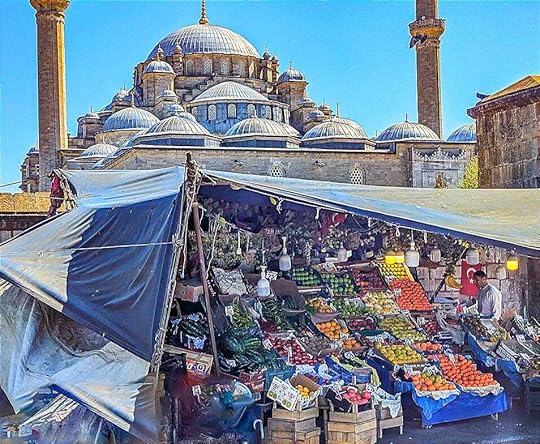
Turkey has some genuinely incredible mosques, including this mosque in Fatih.
But I didn’t understand until we spent time living in Turkey how central the mosque is to daily life.
AARHUS, DENMARK
September 19, 7:21 AM
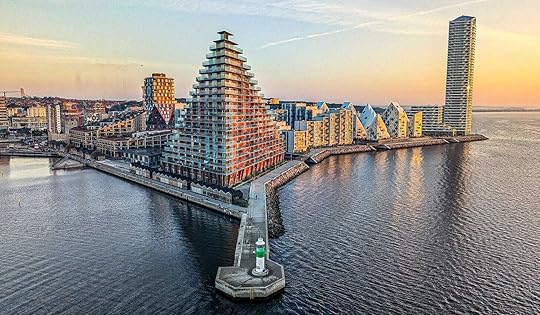
After visiting Copenhagen, our cruise ship docked in Aarhus, Denmark’s second-largest city.
As we sailed in that morning, I lucked out by being in the perfect spot as we passed right in front of the Aarhus Docklands, a newly developed residential neighborhood with a futuristic look that I love.
TYNTESFIELD, ENGLAND
November 13, 11:15 AM

While I love me some futuristic Scandinavian architecture, I’m also a complete sucker for great Gothic buildings like Tyntesfield Estate just outside of Bristol.
If I were still writing fiction, I would absolutely set a ghost story here.
LIVERPOOL, ENGLAND
August 20, 1:55 PM
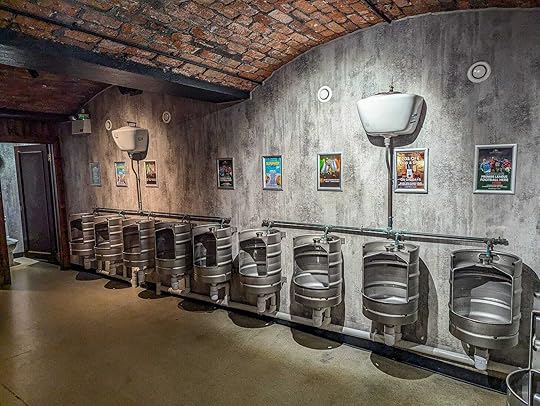
Yes, I know my one photo from Liverpool should be all about the Beatles, but when I stopped to use the bathroom at this restaurant, I laughed out loud at how the steel beer barrels had been repurposed.
VALENCIA, SPAIN
February 21, 7:38 AM

Visiting Valencia, Spain’s remarkable City of Arts and Sciences in Valencia, Spain, felt like being in a science fiction movie. This explains why Doctor Who, Tomorrowland, Westworld, and Andor all filmed scenes here.
PORTSMOUTH, ENGLAND
July 27, 1:42 PM

Portsmouth Historic Dockyard is a remarkable collection of British naval history, including the HMS Warrior, once the largest and most powerful warship in the world; the Mary Rose, Henry VIII’s favorite ship before it unceremoniously sank in battle without getting off a single shot; and the HMS Victory, the ship Lord Nelson captained to lead Britain to victory over the Spanish at Trafalgar.
Hail, Brittania!
Rotterdam, Netherlands
September 13, 3:26 PM
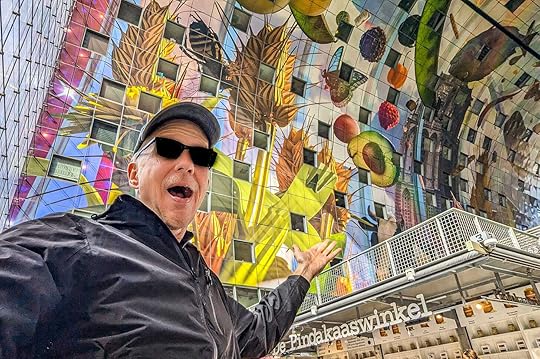
I’d always heard Rotterdam was one of the most boring cities in Europe because it had been so heavily bombed in WWII, and what was built after the war wasn’t all that. But between the Cube Houses, Erasmus Bridge, the Depot, and Markthal, pictured above, I found it anything but dull.
REYKJAVIK, ICELAND
August 5 12:23 AM

Iceland isn’t quite far north enough to qualify as the land of the Midnight Sun, but this midnight sunset was one of the most beautiful I saw in a year of beautiful sunsets.
OSLO, NORWAY
July 12, 10:51 PM
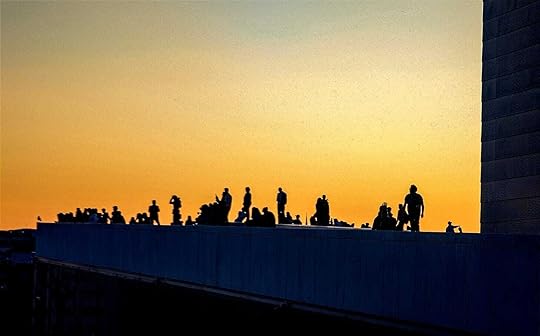
Every clear summer night, Oslovians gather on top of the Opera House to enjoy the sunset. Norway is another northern country where the summer sun sets very late.
Adults drink and listen to music while smaller kids play. Yes, there are kids here even this late at night — because when you have to deal with Norway’s long, dark winters, everyone wants to make the warm summer days last as long as possible.
VALENCIA, SPAIN
March 10, 9:15 PM

As we approach New Year’s Eve, what better way to finish than with this amazing fireworks display from Valencia, Spain.
That’s it — I hope you enjoyed my peek back at 2024!
If you enjoyed this newsletter, I would appreciate your sharing it with someone you think might also like it.
Michael Jensen is a travel writer, amateur photographer, and novelist. Check out his other newsletter about his travels at BrentAndMichaelAreGoingPlaces.com.
November 28, 2024
A Magical Meal in Macedonia
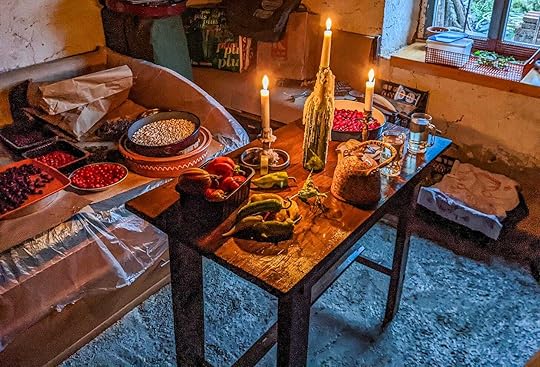
Happy Thanksgiving to all of my American subscribers, and a belated happy Thanksgiving to all the Canadian readers! (And hello to everyone else!)
This Thanksgiving Day, Brent and I are onboard the Sky Princess as we head back to the U.S. for the Christmas holidays.
Turkey, potatoes, and cranberries are on the ship’s menu for tonight, though I’m keeping my expectations in check about their quality.
Thanksgiving is a holiday I love for many reasons: crisp fall days, corn mazes and bright orange pumpkins, and the promise of Christmas right around the corner.
Alas, celebrating it outside the U.S. has never quite measured up, no matter how hard we try. I especially miss the smell of a roasting turkey filling the house, leftover turkey sandwiches, and football games.
Since I don’t have a heartwarming story about celebrating Thanksgiving while abroad, I wanted to share photos of what might be the best meal I’ve eaten over the past seven years.
It happened in the tiny village of Brežani in the remote mountains of North Macedonia, about an hour from where Brent and I were staying on Lake Ohrid in September of 2022.
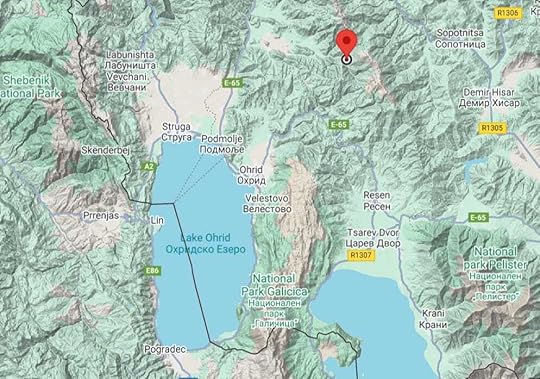 That’s Brežani way up in the mountains all by itself.
That’s Brežani way up in the mountains all by itself. A meal cooked entirely over a campfire and a single kerosene flame.
A magical meal.
It was set in motion one morning while I sat on a bench along the lake and struck up a conversation with Mitko, a local man who worked as a stained-glass artist.
Mitko and I chatted for a while, and before I knew it, he had invited me — and Brent, who was back at the apartment — to join them a few days later in Brežani. In this remote mountain village, he and his wife, Mimoza, had been slowly renovating an old, abandoned house.
So there we were in the back of a van winding our way up a dirt road to that remote mountain village.
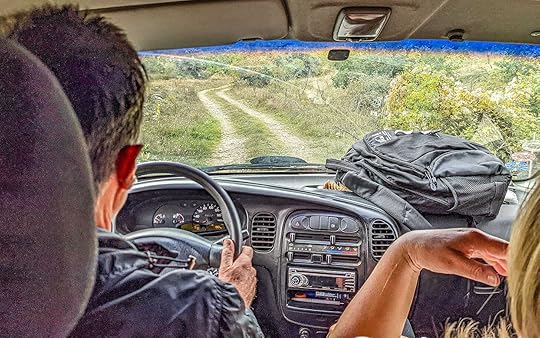 Kilometer after kilometer on this two-lane dirt track into the mountains. With strangers!
Kilometer after kilometer on this two-lane dirt track into the mountains. With strangers!It felt odd to trust a virtual stranger enough to do this, but I had visited Mitko’s studio, and it seemed pretty unlikely he was up to something nefarious.
On the other hand, it would make a great opening scene for a horror movie titled Macedonia Cannibal Massacre.
Hey, life is an adventure, right?
When we arrived at the village, it was in a small valley that was genuinely remote. And small. And mostly abandoned.
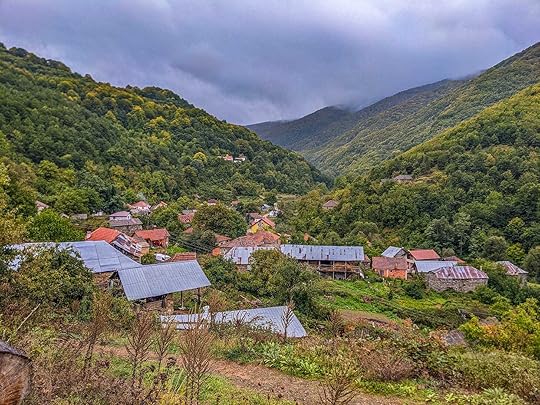 Brežani! And, yeah, that’s all of it.
Brežani! And, yeah, that’s all of it. Nestled in the Mokra Mountains, Brežani had once been a vibrant village of 700 people most living as farmers and shepherds.
 Jovan still lives in Brežani and tends to his flock.
Jovan still lives in Brežani and tends to his flock. Red peppers and tomatoes were essential and used in many traditional dishes, including ajvar, possibly the best condiment in the world.
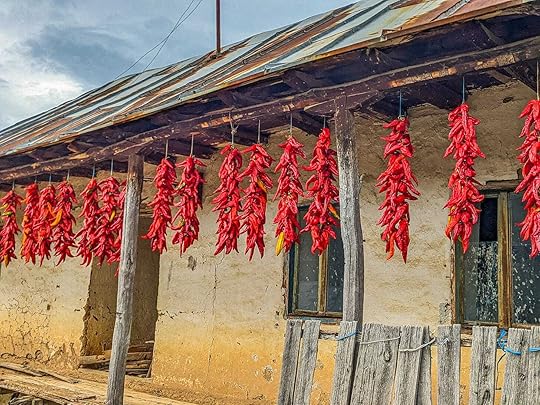 When fall arrives, red peppers are hung out to dry all over Macedonia.
When fall arrives, red peppers are hung out to dry all over Macedonia. However, grapes were also widely grown since they were used with plums to make rakia, a very popular drink throughout the Balkans.
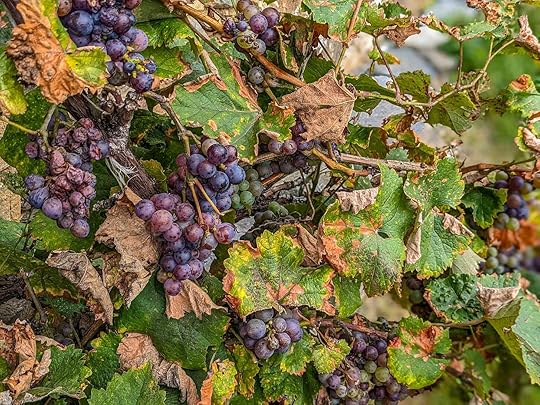 Ready to be harvested.
Ready to be harvested. Alas, over the years, Brežani dwindled to fewer than two dozen permanent residents as agriculture grew less important and young people drifted away for better opportunities and more exciting lives.
The harsh weather, neglect, and the years took their toll on the village.
 Not unusual in Brežani. Some houses have been abandoned for so long, they are completely covered with ivy.
Not unusual in Brežani. Some houses have been abandoned for so long, they are completely covered with ivy. As time passed, the village spiraled further into disrepair and abandonment.
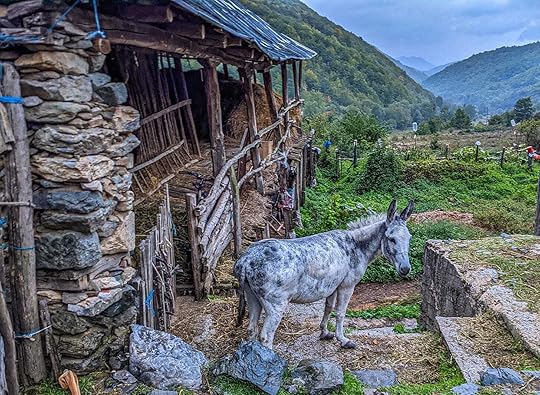 This fellow decided to stay.
This fellow decided to stay. However, not everyone left Brežani!
Marija, age 84, had remained in the same house where she and her husband raised their two sons. After her husband died and her boys moved to the city, Marija stayed in Brežani, tending her enormous garden — all alone.
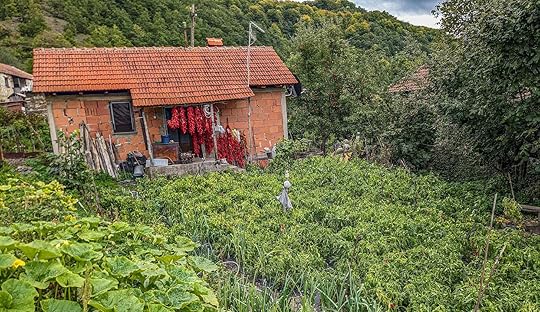 Mitko and Mimoza’s closest neighbor Marija.
Mitko and Mimoza’s closest neighbor Marija. So when Mitko and Mimoza wanted a simpler way of living, they decided Brežani was the place.
They purchased a derelict seventy-year-old house in the village and set about restoring it. Despite their work, it still didn’t have running water, electricity, or even a working toilet when we visited.
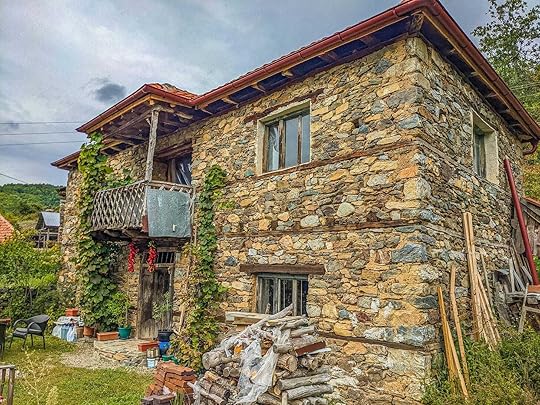 Built more than seventy years ago, the house had been badly neglected, but Mitko and Mimoza have worked hard to restore it.
Built more than seventy years ago, the house had been badly neglected, but Mitko and Mimoza have worked hard to restore it.When Mitko and Mimoza came up from Ohrid, where they currently lived, to work on the house, they slept in a tent.
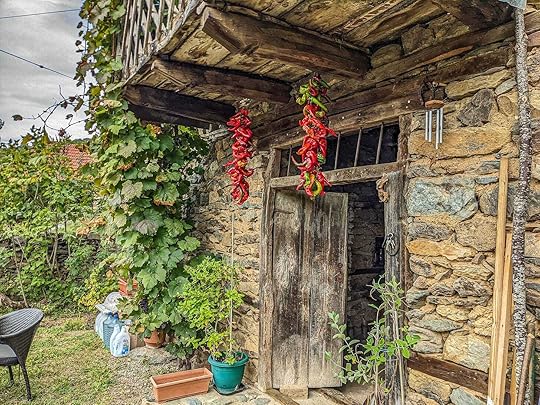
They weren’t in any rush. For them, building a peaceful life in the village seemed almost as important as finishing the house.
So, on each visit, they did a little more work and, more importantly, savored the experience of being far from everything.
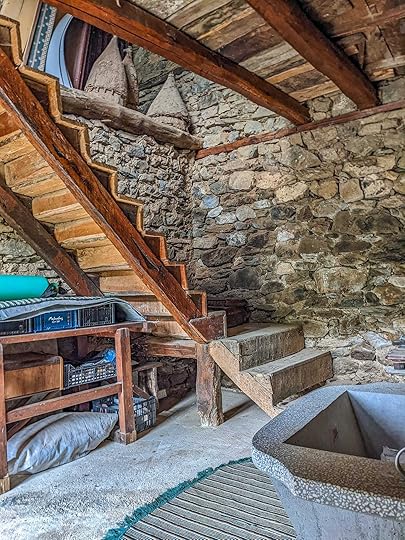 Rustic, but it’s going to be lovely when it’s finished.
Rustic, but it’s going to be lovely when it’s finished. So far the roof had been fixed and the outside walls patched up. The bottom floor had been cleaned up and had a rudimentary kitchen, but the upstairs was nothing but storage.
Time to start cooking! Everything was made from scratch.
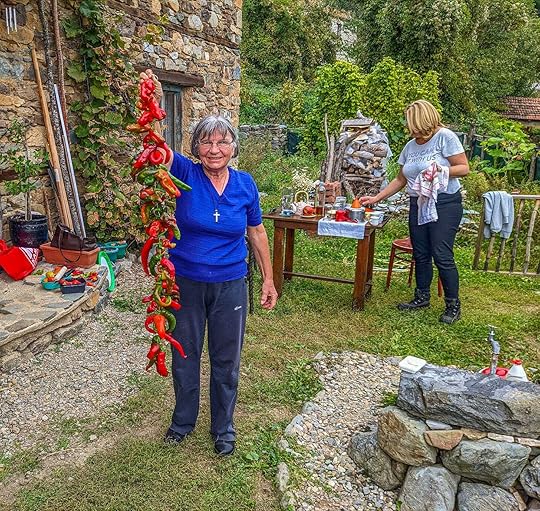 Mitko’s aunt holding the peppers, Mimoza to the right.
Mitko’s aunt holding the peppers, Mimoza to the right.First, they had to wash and prepare the tomatoes and peppers…
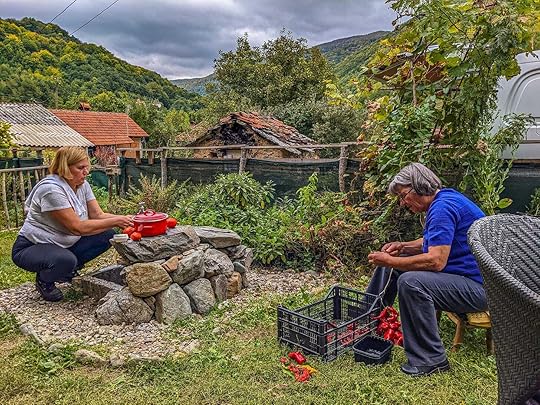
…and then roast the peppers over an open fire.

Have you ever smelled peppers roasting over an open fire in the mountains?
Oh, my god.
They have a smoky sweetness that perfumes the air. It made me feel like I’d returned to a simpler era.
We offered to help with the cooking but were told in no uncertain terms that, as guests, we were expected only to sip rakia and enjoy the food and company — which included other villagers who were constantly stopping by.
Except for Mitko and Mimoza, no one spoke English, but that didn’t matter. In the quiet of those Macedonian mountains, we could all still enjoy each other’s company.
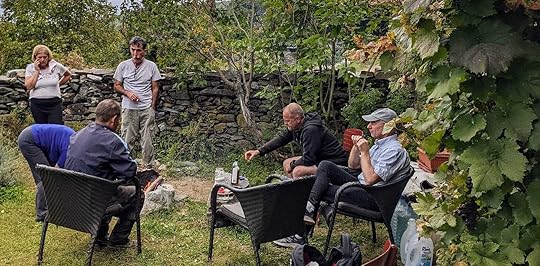 Throughout the day, villagers dropped by for a drink and a chat.
Throughout the day, villagers dropped by for a drink and a chat. While Mimoza and Mitko’s aunt did most of the cooking, Mitko did a steady stream of chores: fetching water, keeping the fire going, picking vegetables, and more.
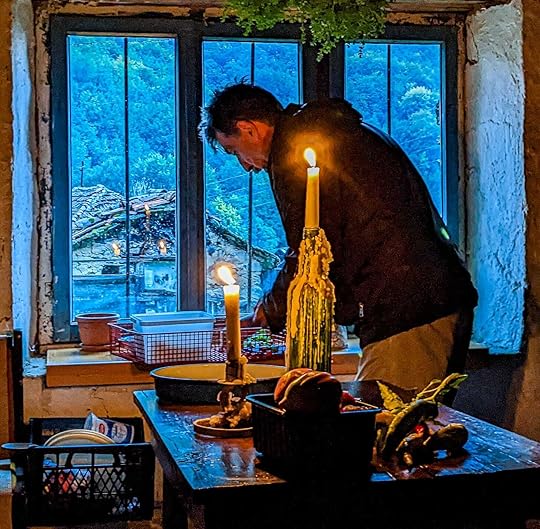 Mitko hard at work.
Mitko hard at work. Then the food started coming. First, a tomato and onion salad, using tomatoes so fresh they burst with sweetness offset by a dash of vinegar.
Of course, we had to have rakia with it. But be careful! This alcohol is potent stuff!
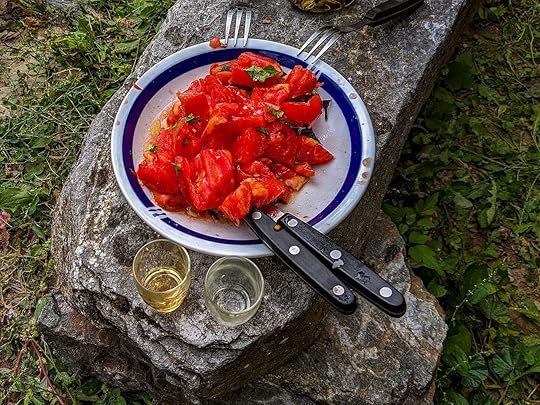
Assuming the weather held on an already cloudy day, the plan was to eat outside.
Looking at the table, I felt like I’d stepped into a dinner party in a foreign film where everyone would be impossibly witty, and the conversation would flow like, well, rakia.
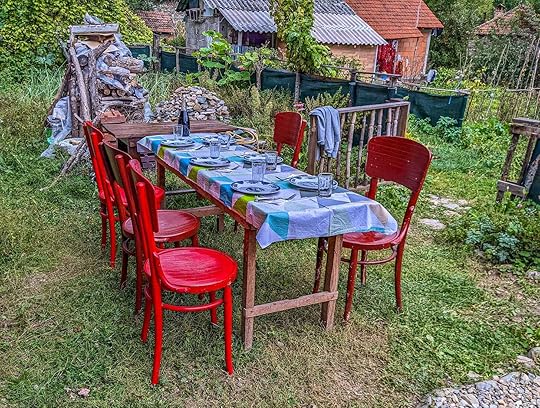
Meanwhile, inside the house, Mimoza continued to prepare the main meal.
I peeked through the window.
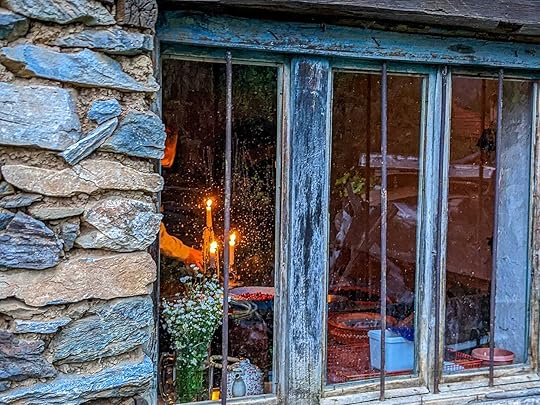
I wanted a better look, so I snuck inside — and felt like I’d stumbled into a painting by some long-dead European master.
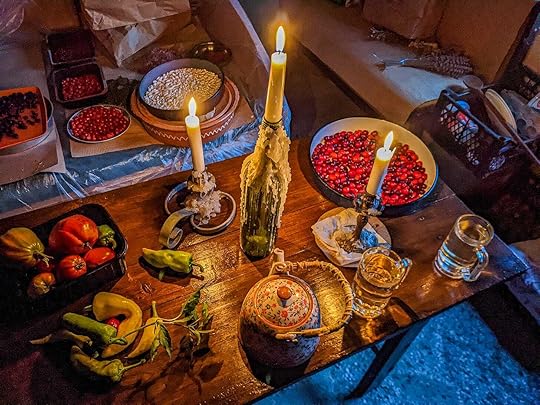
One table was filled with shelled white beans and pans and bowls of forest fruit Mitko and Mimoza had harvested on our way up to Brežani.
Food didn’t come any more fresh than this.

Then there was the smell inside the house! Carmelized onions! Garlic sizzling in oil! Simmering meat!
Using only a single propane burner, Mimoza had somehow prepared a feast.
There was turlitava, a traditional Balkan stew cooked in an earthenware pot.

Mimoza told me this dish included pork, beef, and lamb, plus onion, peppers, potato, green beans, okra, parsley, garlic, tomato, and carrots, all simmered together for hours.
Then, there were the roasted peppers, which were seasoned with oil, vinegar, and garlic.
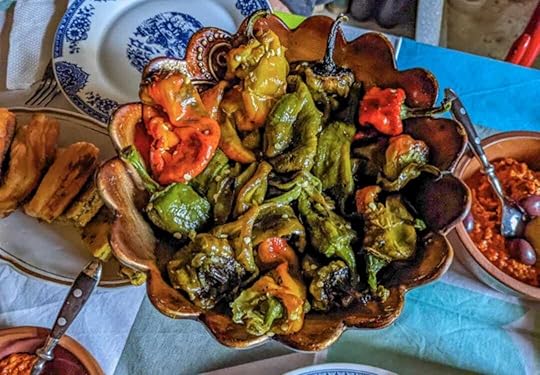
There was also tavče gravče, beans baked in the oven; komad, a pie with cheese and eggs; gibanica, pastry sheets stuffed with cheese, sour cream, and eggs; proja, a bread made with corn flour, leeks, and, yes, more cheese; and a simple cucumber salad.
And, of course, ajvar, the roasted red pepper dish about which Macedonians are (correctly) passionate.
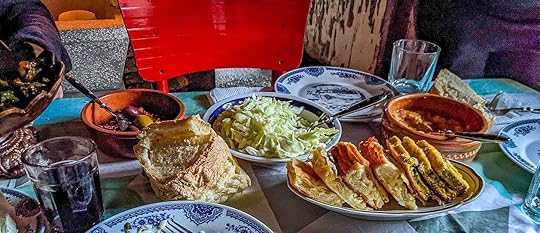
Unfortunately, our luck with the weather ran out, and we had to move everything indoors because of rain.
I won’t lie. I was disappointed because eating outside in a tiny Macedonian valley sounded incredibly romantic — especially compared to eating inside a house far from livable.
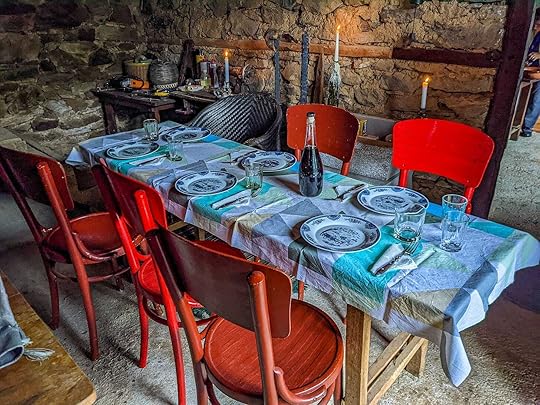
But I was wrong.
The magic of that Macedonian day persisted because once the candles were lit, the food laid out, and our new friends gathered around the table, everything was…
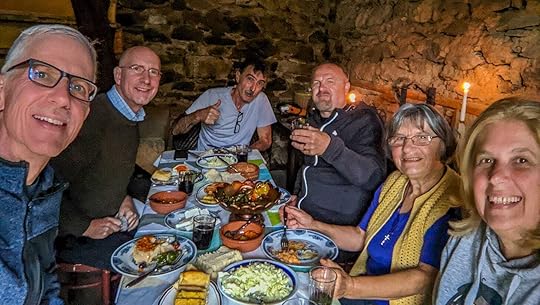
…perfect.
The dishes were some of the most flavorful I’d ever eaten. The turlitava was rich and hearty, the peppers grilled to sweet, smoky perfection, everything bursting with freshness and flavor.
Even in the finest restaurant, you couldn’t buy a meal like this.
As we finished the last of it, I looked around the table and thought, This is why we travel.
To meet people like Mitko and Mimoza. To venture to remote mountain villages and eat food that connected us directly to Brežani’s bygone days.
Sure, we’d soon be missing another Thanksgiving Day back in the States, but I didn’t care. I could still be thankful — and now I had so much more to be thankful for.
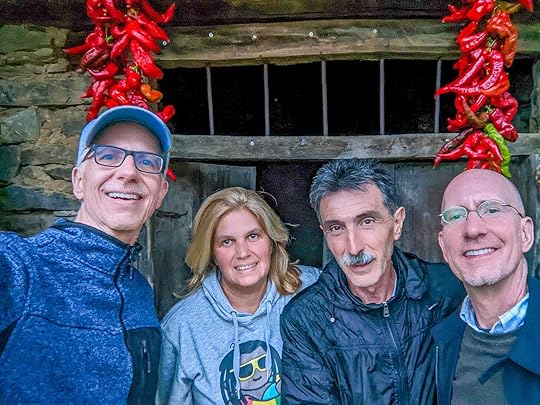 Brent and I with Mimoza and Mitko.
Brent and I with Mimoza and Mitko. If you enjoyed this newsletter, I would appreciate your sharing it with someone you think might also like it.
Michael Jensen is a travel writer, amateur photographer, and novelist. Check out his other newsletter about his travels at BrentAndMichaelAreGoingPlaces.com.
November 13, 2024
Let's Go On a London Pub Crawl!
During our stay in London two years ago, I absolutely fell in love with the city’s pubs.
I wrote a newsletter about how much I adored them.
What frustrated me about that article was that I could only include a handful of the photos I’d taken, and most were collages like this.

Boo! That doesn’t really give readers a sense of how gorgeous these pubs are. And many of my favorite pictures never saw the light of day.
Now, with Michael Takes Too Many Pictures, I can rectify that.
But I’m not simply going to show you a bunch of photos.
No, no, no.
Instead, we’re going on a virtual pub crawl to some of my favorite London pubs. And we’re going to drink ourselves silly along the way.
Please note: these are not just any pubs. They’re some of London’s best “theme” pubs.
What’s a theme pub? It’s awesome, is what it is!
Okay, I’ll be more specific: a theme pub uses its decor, menu, and ambiance to create a unique, immersive experience.
Hmm, that sounds kind of boring. Clearly, I should just show you what a theme pub is.
So off we go!
OLD BANK OF ENGLANDAddress: 194 Fleet St, London
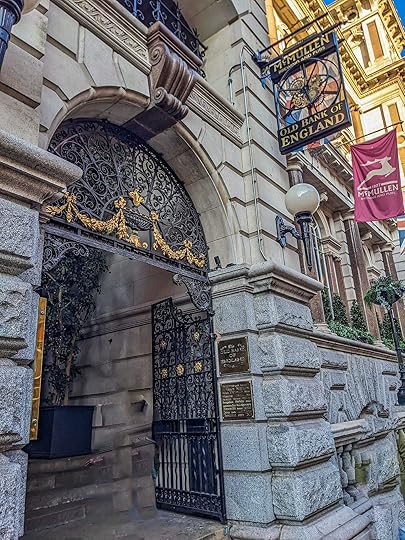
That’s pretty fancy and stuffy looking for a pub, innit? Let’s go inside and check it out anyway.
There’s the bar, and, yeah, this place does look pretty swank. Let’s have our first drink, shall we?

I love ciders, which the Brits do quite well. Mmmm, this one is quite tasty.
This gorgeous building dates back to 1888, when it was the closest branch of the Bank of England to the Royal Courts of Justice. Maybe that’s why it has such a hoity-toity feel.
But check out these chandeliers. I love the golden light bathing the interior.
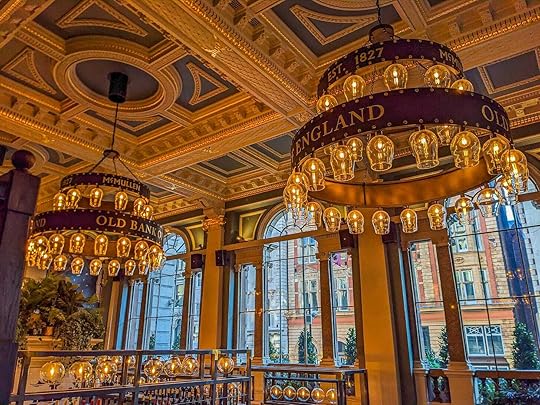
The bank’s vaults once stored a lot of gold — and supposedly even the Crown Jewels. The grand interior is Victorian, which explains the ornate chandeliers, high ceilings, and intricate woodwork.

The original bank was converted into a pub in 1994, undergoing extensive renovations that kept many elements that make this pub so iconic.

Given its original use as a bank, it’s not surprising this pub doesn’t have the homey feel of a more traditional pub. But come on, this place is gorgeous.
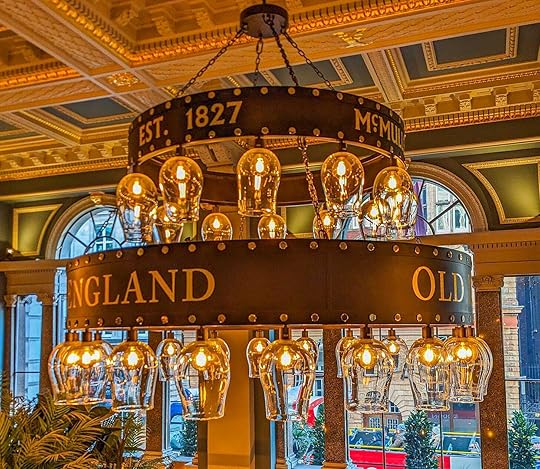
Okay, finish up those drinks. We’ve got a schedule to drink, er, keep. Let’s go!
THE BLACK FRIAR PUBAddress: 174 Queen Victoria St, London
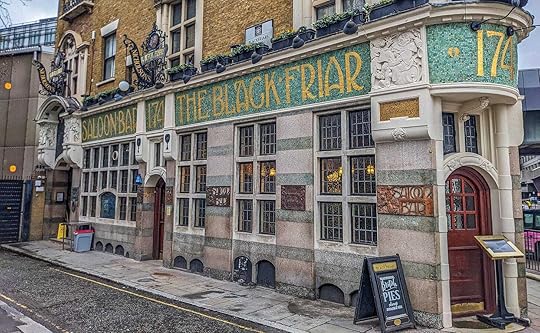
Our second stop is the Black Friar Pub.
Time for our second drink. Mmm, still refreshing!
The Black Friar was built in 1875 on the site of a former Dominican friary. It’s especially well known for its Art Nouveau style, including the intricate mosaics on the exterior and the stained glass inside.
The interior was reimagined and redone in 1905 by architect Herbert Fuller-Clark and artist Henry Poole. The highlights are the copper reliefs depicting cheerful friars in scenes inspired by the friary's heritage.
In case you don’t know, a “friary” is where friars live, while a “monastery” is where, yes, monks live.
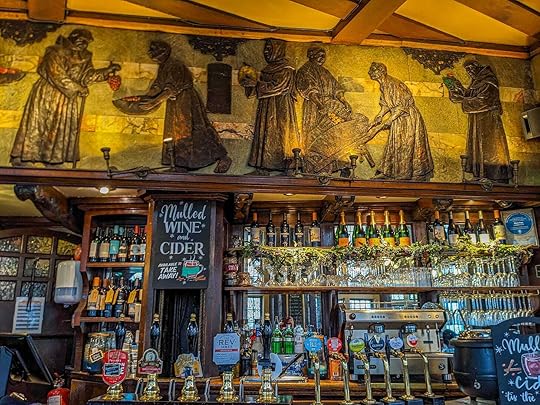
What’s the difference between a monk and a friar?
Monks live a more secluded life of prayer and contemplation, mostly staying inside a monastery’s walls. Meanwhile, friars lead more active lives, frequently engaging with the outside community.

Think Friar Tuck running around with Robin Hood and his band of Merry Men versus St. Benedict, who founded the Benedictine Order.
I definitely would have been a friar.
But friars and monks did have something in common. Both brewed beer! That makes this spot a perfect place for a pub today.
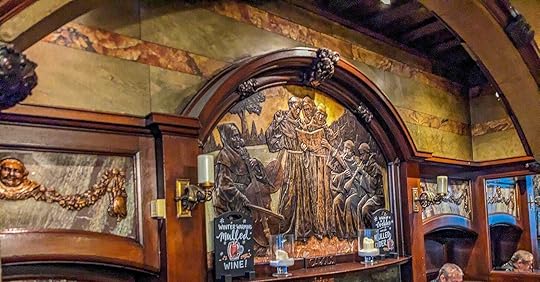
Monks and friars brewed beer as a way to be self-sufficient.
This also made them pretty important in medieval Europe, where water supplies were often contaminated, and beer wasn’t just safe to drink but also provided much-needed nutrition.
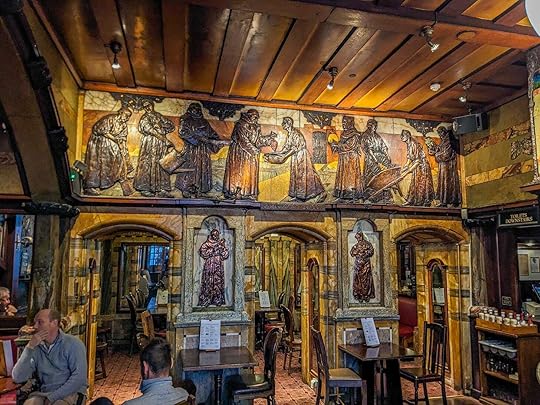
And you thought drinking was only for taking the edge off!
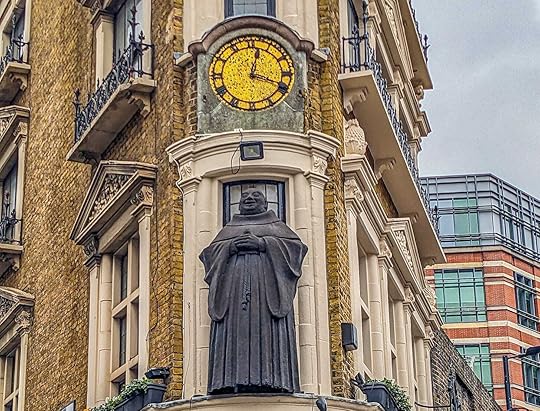
Okay, finish up your drinks. It’s time to move on!
THE SHERLOCK HOLMES PUBAddress: 10 Northumberland St, London

Are you ready for our next pub? Because the game is afoot!
You're probably not a Sherlock Holmes fan if you don’t recognize what I’m saying.
(In the otherwise excellent version starring Benedict Cumberbatch, Holmes offers a much more boring, “The game is on.)
Let’s head inside and get our drinks.
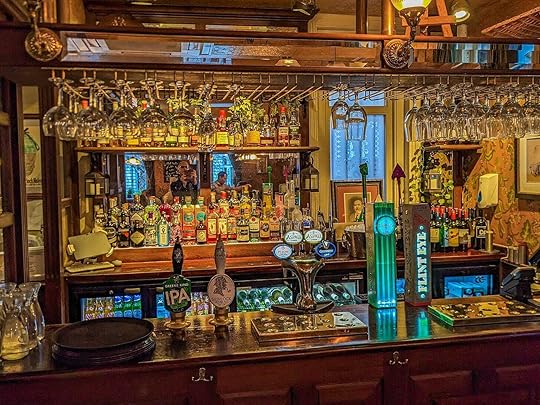
I normally have one cider every couple of weeks, so I’m already feeling a bit light-headed. But in for a penny, in for a pound! Or since we’re in England, should that be “in for a pence, in for a pound?”
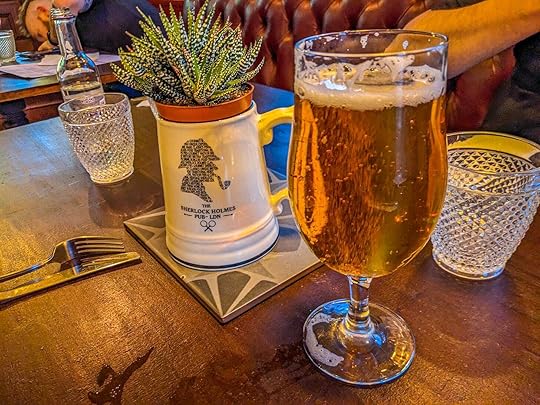
When I first heard about the Sherlock Holmes Pub, I thought it was probably a gimmicky new place cashing in on the rise of themed pubs. And I figured its collection of Sherlock Holmes memorabilia had all been ordered from Amazon.
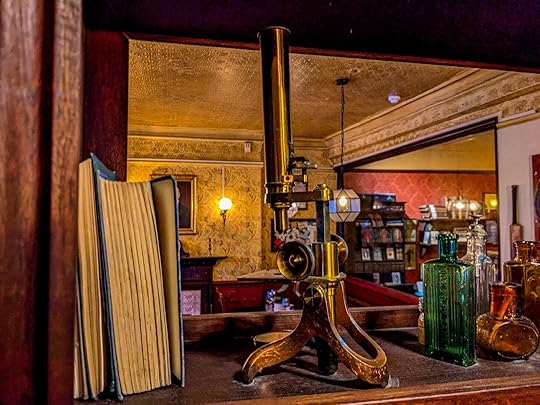
But no! The Sherlock Holmes opened way back in 1957, almost seventy years ago. It was a themed pub before themed pubs were even a thing.

Much of the collection on display is even older. It dates back to 1951 when the Marylebone Public Library decided to create a collection for the Festival of Britain.
But the pub isn’t only a collection of Holmes memorabilia. Patrons can also check out a recreation of Holmes’ sitting room at 221B Baker Street.

Since opening, the pub has been a draw for Holmes’ enthusiasts — including myself. As a boy, I loved watching classic Holmes movies, like The Hounds of the Baskervilles, starring Basil Rathbone.
But I also loved the new series on PBS a few years ago. How about you folks? Any Sherlock fans here?

Okay, everyone, time to go. I don’t know about you, but I’m feeling a wee bit tipsy. Be careful getting up!
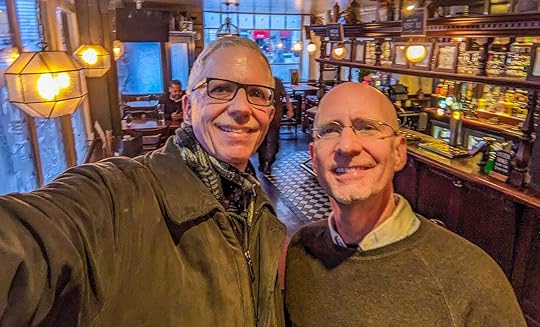 FLIGHT CLUB Bloomsbury
FLIGHT CLUB BloomsburyAddress: 6 Sir Simon Milton Sq, London
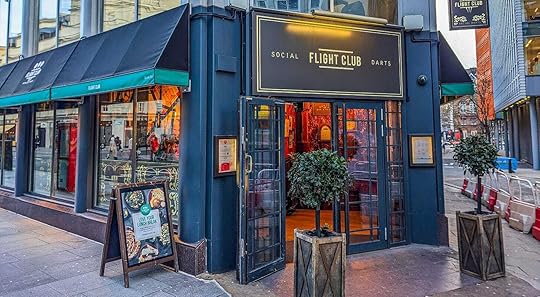
Okay, this place took more work to find than I thought. I guess three apple ciders have really gone to my head. Hoo boy!
Speaking of which, maybe we should’ve come to this pub first. Why?
Because Flight Club — a play on the movie Fight Club starring Brad Pitt — is a pub built around the very British game of darts!
So let’s everyone be careful of our aim, okay?
Let’s head inside.

Check out the gorgeous wallpaper. This place is class with a capital “C.” But don’t get distracted going down those stairs.
If you think the entry is gorgeous, wait until you see the bar right around the corner.
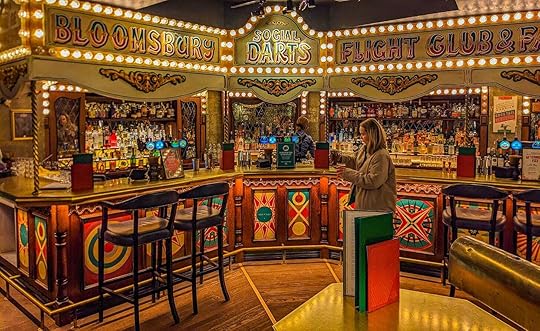
How fantastic is that? Inspired by a carousel, it’s a one-of-a-kind, and I’m pretty sure it’s gonna be one of the highlights of our pub crawl.
The Flight Club has a lot of classy touches, including these fun stained-glass windows.
The horse you see below is named “Andrea” and goes right along with the bar’s carousel theme.
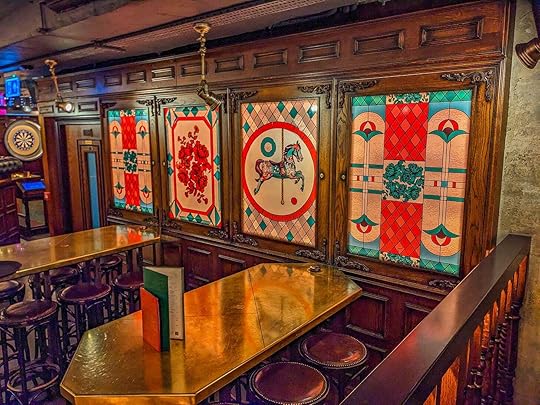
Why is this pub named Flight Club Bloomsbury?
Because the club is located in the Bloomsbury district in London’s West London, long considered a cultural, intellectual, and fashion center of London.
If you’ve heard the name Bloomsbury, it’s likely in association with “the Bloomsbury Set” — writers and thinkers such as Virginia Woolf, John Maynard Keynes, and E.M. Forster. I bet they used to get drunk and play darts here.
Speaking of which, grab a drink and play a game ourselves.
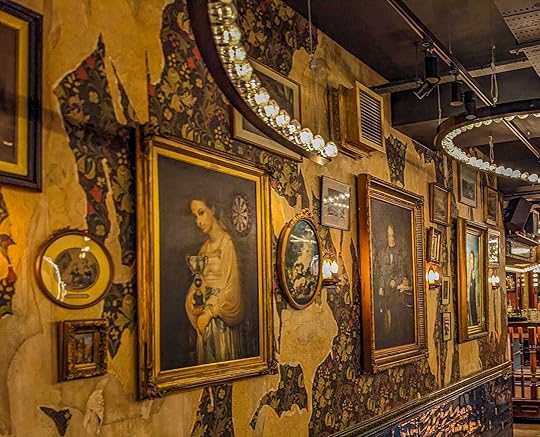
Check out this sweet setup. It has great wood paneling and that fantastic mural, and it has a high-tech scoreboard that electronically senses where your dart hits.
Here’s my first throw…
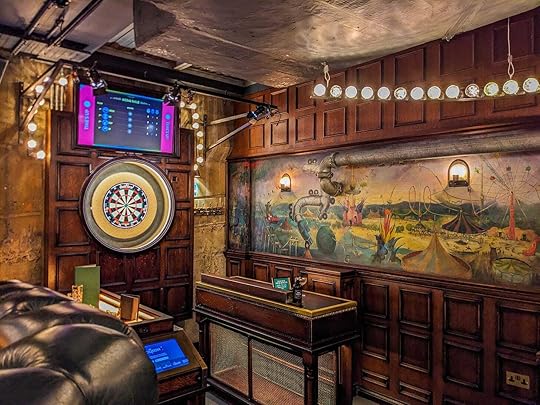
Oh, geez, sorry about that, Barb. Are you okay?
That doesn’t look like too much blood. Okay, yeah, it really was a bad idea coming here this late into our pub crawl.
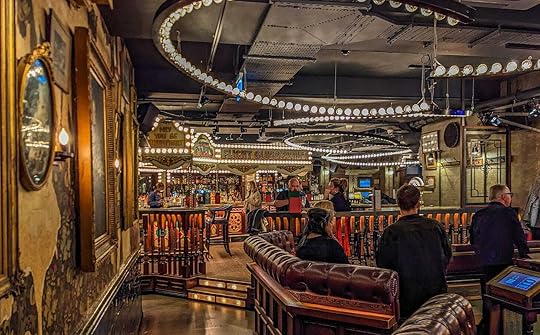
Why don’t we all finish up our drinks and head out before someone loses an eye? That’s four down and two to go!
MR. FOGG’S TAVERNAddress: 58 St Martin's Ln, London
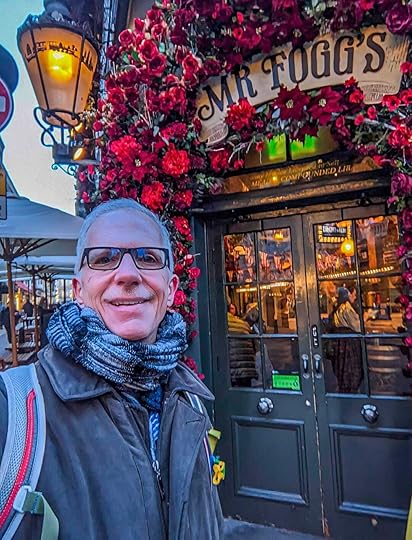
Is everyone here? Let me count. One, two, three, five, two…
Wow, those ciders are potent! Oh, well, it’s not like you guys signed releases.
Okay, so this is Mr. Fogg’s Tavern, and I fell in love with it the minute I walked by.
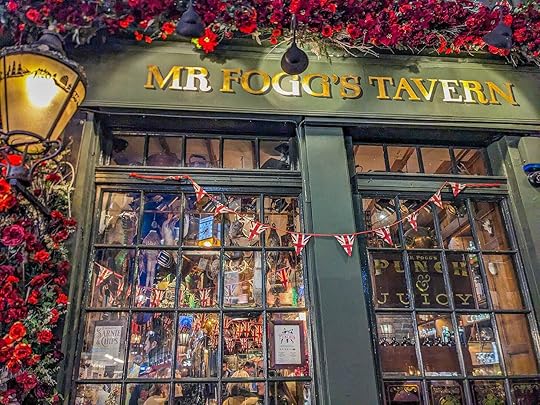
Take another look at the doorway!
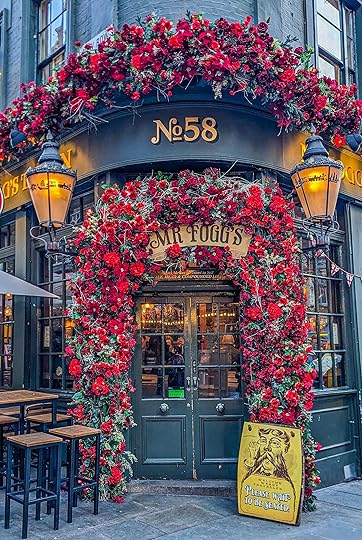
As us Americans like to say, “Go home big!” No, wait, “Go big or go home!” That’s not it either. Got it!
“GO BIG OR GO HOME!”
Anyway, Mr. Fogg’s really went big. Let’s go inside and check it out. I hope we can get a seat. The first time I came here, it was absolutely jam-packed.
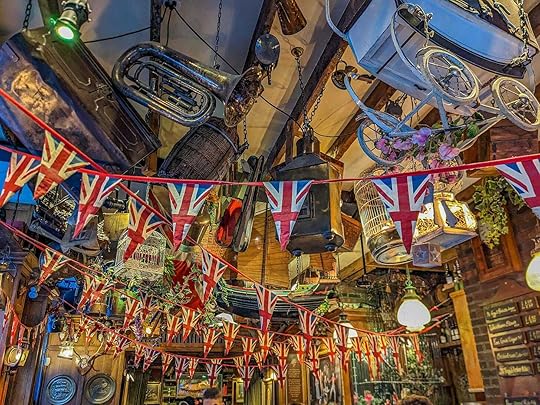
Look, there’s an empty table. Grab it!
What did I say about going big? Have you ever seen so many Union Jacks? And look at that ceiling! There’s a French horn! A pram! A birdcage! Why?
Why not!
There are also antique pots, a brass diving helmet, and taxidermy.
Crazy, huh?

This rounds on me, and then I’ll tell you a bit more about Mr. Frogs, er, Mr. Foggs.
This Victorian-style pub is inspired by Phileas Fogg, the fictional adventurer from the Jules Verne novel Around the World in 80 Days. Maybe all the stuff up on the ceiling are things would’ve Mr. Fogg picked up on his travels?
Unlike some of the spots we’ve been to today, Mr. Fogg’s really goes in on the old-fashioned English pub feeling, and I love that.
On Thursday evenings, the pub hosts Cockney sing-alongs. Those sound like a blast.
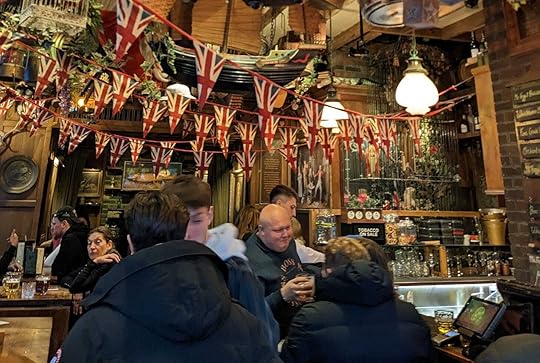
Did you notice the bartenders? They’re dressed up like we’re back in the 19th century, which would be totally awesome. Well, except for all the pollution from burning coal, the horse manure in the streets, women and minorities not having rights, and the whole Jack the Ripper thing.
But I digress.
On that note, it’s time for us to head off to our final destination. Grab your coats and I’ll meet you outside.

What’s that? Yes, I’m ready. I just wanted to take one last look because I like this place so much.
THE RABBIT HOLE PUBAddress: 151-153 Greyhound Lane, Streatham
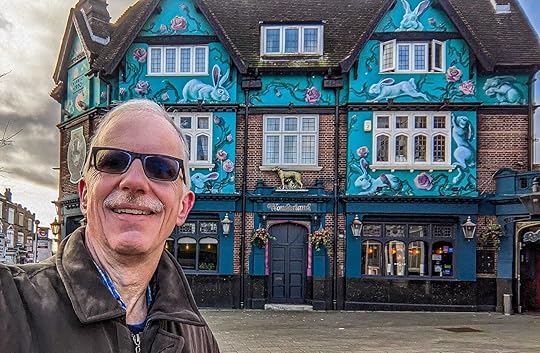
Are we ready for our last pub?
I saved it for last because it’s pretty trippy and I figured it would be good if showed up here…snoggered? Snookered?
Well, whatever they call drunk in Jolly Old England.
The first time I walked by the Rabbit Hole, I thought I was hallucinating. Was I really seeing a bunch of blue rabbits on that building?

Yup, I was.
Then I went inside — and things got more trippy.
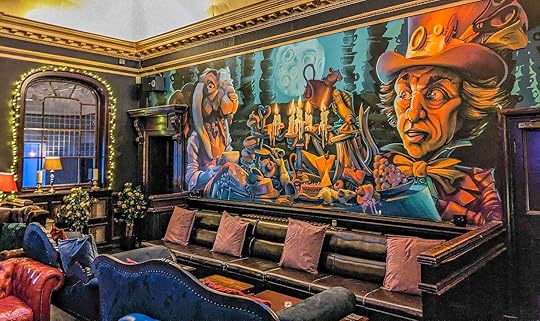
How is that for a freaky mural? What vibe is this pub going for? Orange maniac? English LSD trip?
Because that mural freaks me the hell out.
Let’s go to the bar and get a drink, although given how bizarre this place is maybe that isn’t the best idea.
Oh, well! We’re almost done anyway.
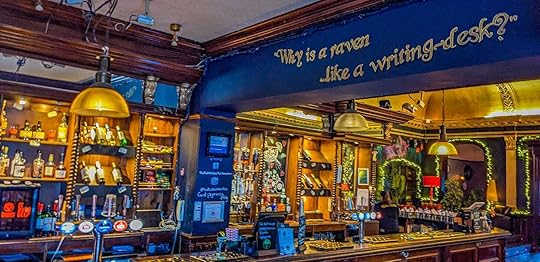
At least the bar looks relatively normal. Get your drink and take a look around and see if you can figure out what’s going on here.

Check out the blue little girl. And that bloody rose.
I told you this pub was trippy!
As you can see, the theme is Alice in Wonderland.
But not in a “let’s take the kids to the pub sort of way.”
It’s more like, “Let’s take some shrooms and see what happens” kind of way.
Let’s look more closely at Alice.

Her face is blue, but her hair is strawberry blonde. That’s unsettling. And is that really the face of a kid? She looks kind of hard to me as she spies on the Cheshire Cat, which is so far the most normal thing here.
The entire experience would be deeply unsettling if my head weren’t spinning from six pints of cider.
But the rest of the decor is quite classy. I could see hanging out here with a pint. Well, at least if they covered these murals.
Let’s pull up a chair and wrap things up.

What did everyone think? Aren’t London’s themed pubs pretty danged cool?
Awesome! I'm glad you enjoyed it. But again, Barb, I'm really sorry I hit you with that dart.
But at least it looks like the bleeding has finally stopped.
If you enjoyed this newsletter, I would appreciate your sharing it with someone you think might also like it.
Michael Jensen is a travel writer, amateur photographer, and novelist. Check out his other newsletter about his travels at BrentAndMichaelAreGoingPlaces.com.



